 By Ray Rivers By Ray Rivers
February 26th,2019
BURLINGTON, ON
After the dust had settled on the three by-elections, the Liberals came out one seat ahead. It was the one they used to own – in Outremont, Quebec. The Tories cleaned up in York-Simcoe to nobody’s surprise. But the prize was in Burnaby South where NDP leader Jagmeet Singh easily won, confounding the pundits, though it was a seat previously held by his party.
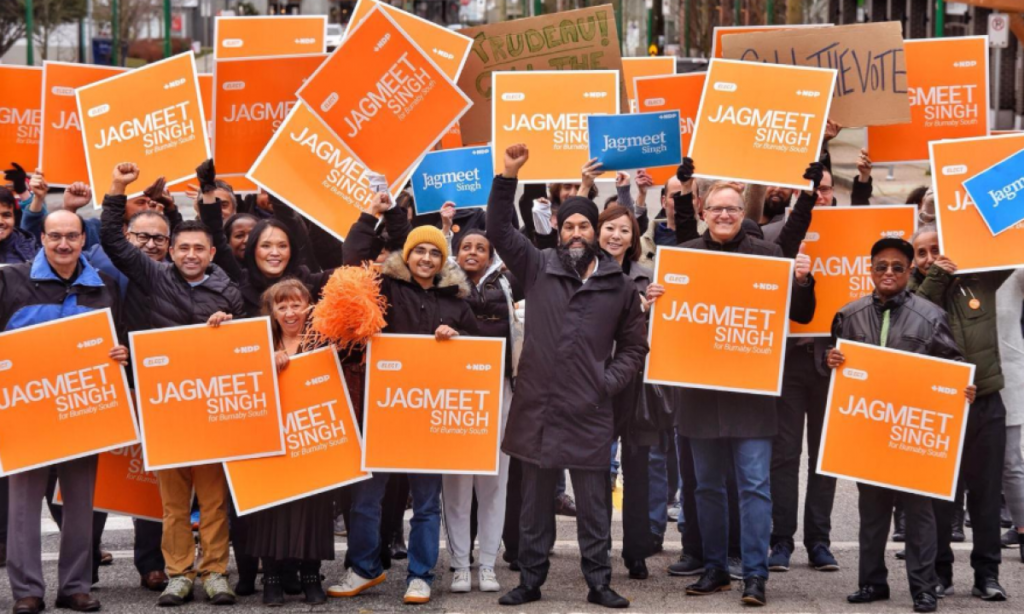 Jagmeet Singh now has a seat in the House of Commons; now the hard part for him begins. Political analysts will struggle trying to dissect Singh’s victory in that ethnically diverse riding of Burnaby South. The Liberals placed second, ahead of the Conservatives but well below where they might have been thanks to some unfavourable headlines. To begin with their initial candidate had to resign after making racist comments. She’d argued that her chances of winning were good since more voters were of Chinese origin, like her, than Indian (Sikh), like Singh.
The Liberals rushed to replace her but clearly had lost valuable campaign time and ended up with a parachute candidate. In fact, Singh was the only candidate from a major party who actually lived in the riding, having moved there from Ontario. He had campaigned hard for this win, as if his future depended on it. And it did.
Party leaders are rarely defeated, perhaps in the spirit of fair play among voters. But the odds were out on Singh. Some committed Conservative and Liberal voters may have decided to stay home just to give Singh a chance. Still with an overall turnout of 30%, this was a more representative poll than either of the other two by-elections that night. But perhaps it was the weather helping the turnout – always kinder to voters in La La land.
It is no secret that Liberals had been musing whether their chances in the next election would actually be better with Mr. Singh sitting in Parliament or the NDP scrambling for a new leader. But then scrambling for a new leader didn’t hurt the Ontario Tories last election. And it’s also no secret that some in his own party were having misgivings about their last choice for NDP leader. They were not so quietly saying that there would be no second chance if Singh lost.
But there may have been other factors. For example, the provincial NDP is locked in a legal and political fight with Alberta’s NDP and the Trudeau government over the Trans Mountain pipeline, and Singh’s own objections to the pipeline, and the oil sands in general, no doubt played a role in his victory. Burnaby is the terminus of the pipeline and potential bitumen spills and enhanced tanker traffic are real concerns.
The NDP and Greens were alone in this opposition to more oil, but the absence of a Green Party candidate meant that Singh got all of those anti-pipeline votes as well. And on the topic of vote splitting, Maxime Bernier’s new People’s Party made a decent first showing in this riding, getting a third of the right-wing vote, and holding the real Conservatives back from getting to second place. But then the wild west is where the more libertarian/reform minded parties tend to do well, so that should not have been too surprising.
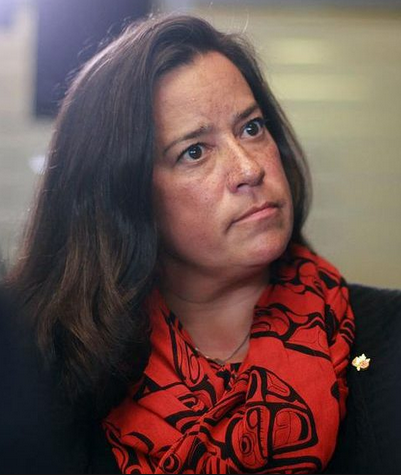 Jody Wilson Raybould – probably not a woman you want to argue with. The Liberals were also undoubtably hurt by the Wilson-Raybould/SNC Lavalin issue. The riding of the former Attorney General (AG) is just down the hall from Burnaby. Sometimes the mere mention of a scandal is enough to sideline any politician. And Trudeau and the Liberal brand have already been damaged, tarnished by allegations of political interference in favour of the Quebec based industrial giant, SNC Lavalin.
Nothing happened! Lavalin is going to court to face the music. But the mere fact that the PM or one of his staff or his senior bureaucrat may have spoken to the AG about this matter is being referred to as pressure. And this is where it gets crazy. Because the AG is just another Liberal politician and a fellow Cabinet minister, and would have been expected to discuss the SNC case with her colleagues in that capacity. But was she pressured?
Jody Wilson-Raybould is a very accomplished person with an extensive and impressive resume. She was a BC provincial crown attorney, land claims negotiator and Regional Chief of the BC Assembly of First Nations. Recruited into the Liberal family as late as 2013 by Mr. Trudeau she was appointed Minister of Justice and Attorney General following the 2015. election. There is an historical connection between Justin and Jody, since their fathers had tangled in discussions leading to Canada’s constitution.
Wilson-Raybould is to testify before the Commons Justice Committee this week, so that everyone may find out what her ‘truth’, as she calls it, really is. Mr. Trudeau, for his part, has not addressed why he chose to demote her just months away from the next election. She had completed a milestones report of the many accomplishments during her three years as AG, which included legislation on marijuana, medially assisted dying and impaired driving legislation.
 Jody Wilson Raybould: Handles media well, doesn’t appear to do selfies. There are some who would detract as to how well she had served her time as AG. But she also has a lot of followers, particularly since she resigned from the Trudeau Cabinet. Wilson-Raybould has stated that she is a Liberal and plans to run in the next election. So one has to ask why she is doing this. Why is she creating a crisis that might well sink any hope of the Liberals retaining government and Mr. Trudeau continuing as Prime Minister?
But perhaps that is the plan. Jody’s father once told Pierre Trudeau that he wanted one of his daughters to become PM. Perhaps once Justin has been defeated she’ll take over.
 Ray Rivers writes regularly on both federal and provincial politics, applying his more than 25 years as a federal bureaucrat to his thinking. Rivers was once a candidate for provincial office in Burlington. He was the founder of the Burlington citizen committee on sustainability at a time when climate warming was a hotly debated subject. Ray has a post graduate degree in economics that he earned at the University of Ottawa. Tweet @rayzrivers Ray Rivers writes regularly on both federal and provincial politics, applying his more than 25 years as a federal bureaucrat to his thinking. Rivers was once a candidate for provincial office in Burlington. He was the founder of the Burlington citizen committee on sustainability at a time when climate warming was a hotly debated subject. Ray has a post graduate degree in economics that he earned at the University of Ottawa. Tweet @rayzrivers
Background links:
Election Results – Trans Mountain – Jody Wilson- Raybould –

 By Staff By Staff
February 26th, 2019
BURLINGTON, ON
An application for a retail cannabis store in Burlington has been received by the Alcohol and Gaming Commission of Ontario. Written comments due by March 6
The Alcohol and Gaming Commission of Ontario (ACGO) has received an application for a retail cannabis store in Burlington at 103-4031 Fairview St.
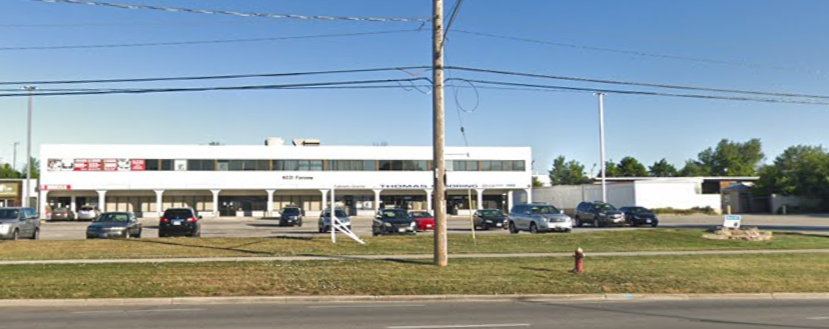 Proposed location for a retail cannabis operation. On Fairview east of Walkers Line. Written comments about the proposed location at 103-4031 Fairview St. will be received by the AGCO until March 6, 2019 and may be submitted online at www.agco.ca/iAGCO. The AGCO will accept submissions from:
• A resident of the municipality in which the proposed store is located
• The municipality representing the area in which the proposed store is located and/or its upper-tier municipality.
Comments submitted to the AGCO should relate to the following matters of public interest:
• Protecting public health and safety
• Protecting youth and restricting their access to cannabis
• Preventing illicit activities in relation to cannabis.
After March 6, the AGCO will consider all written comments and available information to decide whether the application for the proposed store location will be approved.
Mayor Marianne Meed Ward has been an advocate for retail cannabis operations. During the election campaign she said she was surprised at the resistance to retail locations in the city.
When it came to a vote at city council Councillors Shawna Stolte, Ward 4 and ward 6 Councillor Angelo Bentevegna voted to not have retail outlets.
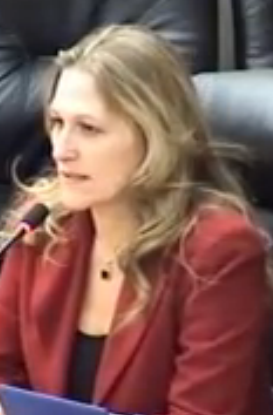 Mayor Meed Ward supports the opening of a retail cannabis site: two of the six Councillors were not n side with her. The Mayor said: “This is the kind of location where it is appropriate for accommodating retail cannabis stores in our city. It is more than 150 metres from any school or any of the other locations of particular concern, including parks, pools, arenas, libraries or recreation centres. And it is also along transit routes and near the QEW/Hwy. 403.
She added that the city “won’t be submitting comments to the AGCO on this application given its suitability. The public can submit their comments by March 6 to the AGCO’s website. Burlington City Council is in the process of creating a task force to develop a set of standard comments we would provide to the AGCO, when applications come forward, that reflect community perspectives on where these should be located.”
Meed Ward has been appointed as one of four members of a working group at the Large Urban Mayor’s Caucus of Ontario (LUMCO), part of the Association of Municipalities of Ontario, that will work to develop similar guidelines for suitable locations. The working group includes mayors of two municipalities that opted in and two that opted out of allowing cannabis retail stores, recognizing that our concerns are similar. The guidelines we create will be shared with the AGCO and our municipalities.

 By Jim Feilders By Jim Feilders
February 25th, 2019
BURLINGTON, ON
Building height and tree removal are like car speed.
There is no maximum.
After a certain point you pay for it in the form of a fine.
The higher the building, the more you pay the government.
The more trees removed, the more you pay the government.
The more you speed, the more you pay the government.
The Planning Act of Ontario has what is known as a Section 37 which allows a developer to offer a benefit to a municipality for additional height. There is no specific rate for the size of the benefit and the additional height permitted.
Section 37 Benefits
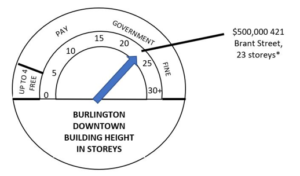 1 to 5 storeys over the limit, XXX per floor 1 to 5 storeys over the limit, XXX per floor
6 to 10 storeys over the limit, XXX per floor
11 to 20 storeys over the limit, $26,316 per floor*
21 to 30 storeys over the limit, XXX per floor
30+ storeys over the limit, XXX per floor
The Highway Traffic Act of Ontario sets out what it is going to cost when you exceed the speed limits.
 1-19 km/h over the speed limit is a $2.50/km speeding fine. 1-19 km/h over the speed limit is a $2.50/km speeding fine.
20-29 km/h over the speed limit is a $3.75/km speeding fine.
30-49 km/h over the speed limit is a $6.00/km speeding fine.
50+ km/h over the speed limit comes with a court decided fine.
Burlington Roseland Pilot Private Tree Bylaw set out what it will cost to remove trees of a specific size
 30 to 50 cm, $1400 per tree removed 30 to 50 cm, $1400 per tree removed
Over 50 cm, $2100 per tree removed
Specialty and boundary trees, see details
That is the Law
If nothing is done, exit signs on the QEW coming from Hamilton might well say:
Next Exit Burlington Downtown, Brant Street
CAUTION
Tall Buildings
Narrow Streets
No Sun
No Trees
No Oxygen
No Beach
No Parks
No Parking
No Transit (call Uber)
No Grocery Stores
No Community Gardens
PROCEED AT YOUR OWN RISK
Next Exit Burlington GO Station Mobility Hub, Guelph Line
CAUTION
No Development for 20 Years
Next Exit Oakville Downtown, Trafalgar Road
Low Rise Buildings
Wide Tree Lined Streets
Sun
Trees
Oxygen
Waterfront Park
Community Parks
Parking
Public Transit
Grocery Stores
Community Gardens
Boating, Swimming, Museums, Shopping, Libraries
Developers Proceed to GO Station Intensification Area
What can be done to create a vibrant Burlington downtown?
Community benefits increased to $500,000 per floor to pay for infrastructure, affordable housing and sustainable development.
City wide private tree bylaw requiring equivalent caliper diameter replacement on site, with no cash in lieu (same as Site Plan Application Guidelines Section 9).
Rezone employment lands for mixed use with minimum job criteria.
Rezone religious institution blocks for mixed use with minimum affordable housing criteria.
Enforce Sustainable Building and Development Guidelines by passing net zero energy/net zero carbon/net zero waste building bylaw.
 Jim Feilders is an engineer by training and an environmentalist by choice. He drives a hybrid car, heat and air conditions his house at a cost of of approximately $375 a year. The views expressed here are solely his own and not necessarily those of the various organizations with which he is associated. Jim Feilders is an engineer by training and an environmentalist by choice. He drives a hybrid car, heat and air conditions his house at a cost of of approximately $375 a year. The views expressed here are solely his own and not necessarily those of the various organizations with which he is associated.

 By Ray Rivers By Ray Rivers
February 23RD, 2019
BURLINGTON, ON
It is bizarre that it has got this far and has gone on for this long.
Recognized as Canada’s national newspaper, though only second by circulation, the highly respected Globe and Mail has created a political scandal out of apparently thin air. The paper has relied on unsupported allegations to make its case that there has been political interference in the administration of federal legal proceedings against SNC Lavalin.
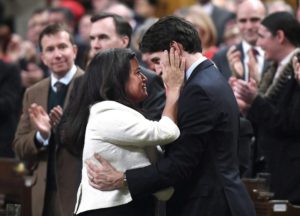 The good days when the Prime Minister appointed Jody Wilson Raybould Minister of Justice and Attorney General of Canada It may have been only a couple of weeks since the Globe’s story hit the pavement but somebody needs to start tallying up the costs for this story, which has grown a lot of legs but no teeth. Already the former Attorney General, Jody Wilson-Raybould and the PM’s Principal Secretary, Gerald Butts, have both resigned. The Commons Justice Committee has had to start special hearings and the Ethics Commissioner has been called in. Lavalin has suffered its first financial loss in six years and its shares are plummeting.
Then there is all the ink that has been spilled over what more and more appears to be the Globe’s non-story. The PM has been consistent. He said the Globe was wrong on day one. Then he followed up emphatically stating that neither he nor his office gave the former AG or her staff direction on the file – in fact reiterating that he had instructed her that the decision to intercede on SNC was hers and hers alone.
The Clerk of the Privy Council, the most senior bureaucrat in Ottawa has identified three critical meetings, where Wilson-Raybould might have felt there had been pressure, including one with him, one between Butts and her senior assistant, and one she had had with the PM back in September, which started out as a meeting on the indigenous file.
 President knew how to apply pressure to the members of Congress. Now the Globe has modified their story from allegations of political interference to somebody pressuring the AG. Pressure? What else does one expect in political life but pressure? Going for that nomination, running an election campaign, debating other candidates, being on call by constituents once elected, standing up in the House, attacking and being attacked. I’m sorry but if you can’t stand the heat get out of the kitchen.
In the matter of SNC, Canadians should expect that our politicians would look long and hard at options to, essentially, putting a Canadian icon, Lavalin, out of business for something a handful of former executives did almost two decades ago, in a land so far away and as corrupt as Libya. Imagine the pressure the over 8,000 Canadian SNC employees will feel if their company shuts down or is sold to a foreign entity, as had happened with Alcan and Rona.
Of course Lavalin might win its court case. But is the cost of prosecuting worth it, when a modern legal disciplinary alternative to lengthy and costly trials for these kinds of white collar crimes exists?
The elected government makes the laws and the prosecutor applies them, but even in TV’s Law and Order there is ample discussion among the parties about the best way to prosecute, and when to accept plea bargains.
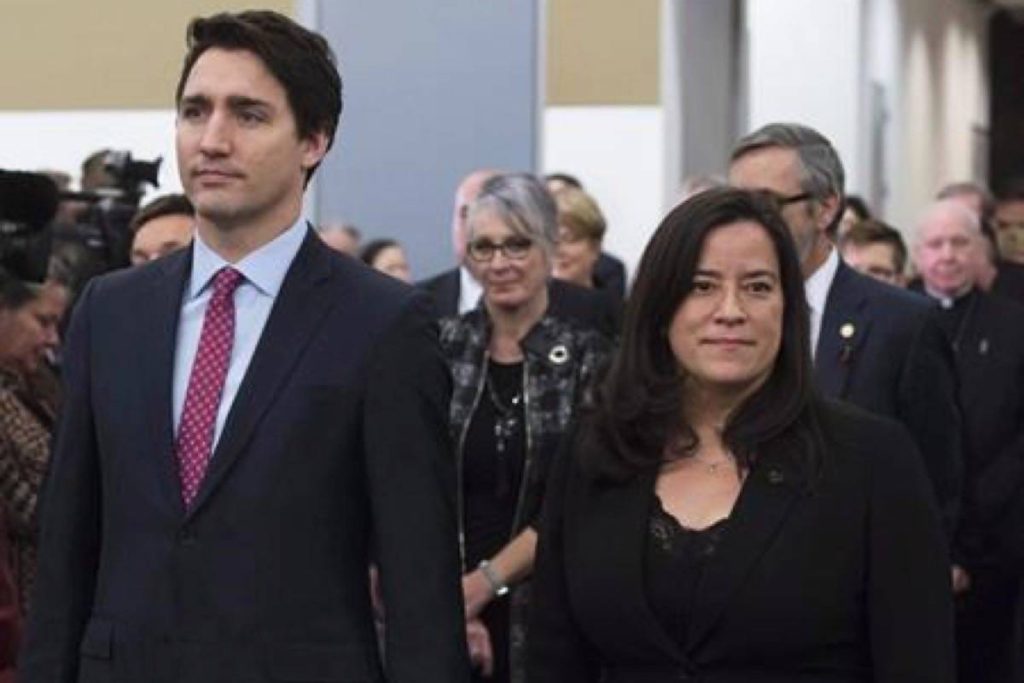 She was no longer the Minister of Justice. The former AG is set to address the Justice Committee early this coming week so we might finally all understand what she means by pressure – assuming those are her words. But even if she felt there was pressure and that others were being insensitive – it obviously wasn’t the pressure that forced her to resign. She resigned well after being shuffled out of the AG’s office.
What goes on in the PM’s Cabinet room is top secret and Cabinet solidarity is at the heart of our governance system. Breaking confidentiality has serious consequences as two federal officials are finding out for allegedly leaking details on shipbuilding contracts. So where did the Globe and Mail get their information? And if it was from the former AG, or anyone Wilson-Raybould had communicated with, wouldn’t that make a mockery of her current protestations about attorney-client privilege?
The PM has told us that he shuffled Jody Wilson-Raybould out of the AG’s office for a number of reasons. Wilson-Raybould understood that being minister of aboriginal affairs would have been an inappropriate appointment for her, given her background. But there are also a number of legal issues coming forward which affect the indigenous communities, including self-government, first nations reconciliation and the Trans Mountain pipeline. Any one of these might find her in a potential conflict of interest situation as Canada’s AG.
 Are newspapers in place to make news as well as report it? The role of newspapers is typically to report the news, not to make it. The Globe has decided on the latter in this case. Perhaps the Globe’s editors were just trying to liven up or balance out the federal political scene. Perhaps they wanted to sell more papers. Or perhaps they were hoping to influence the outcome of the next election with a story replete with unsupported innuendo.
Unless the former AG reveals something earth-shattering with her testimony at the Justice Committee, this will be a sad mark on the pages of the Globe. Trudeau has clearly been affected by all the commotion, losing his friend and chief organizer Butts in the process. Trudeau came to office embracing feminism and an obligation to lift Canada’s indigenous people beyond their current state.
In Jody Wilson-Raybould he, no doubt, saw the embodiment of that ambition. He recruited her, brought her into federal politics, and placed her in one of the most senior appointments in his cabinet. It is no wonder that he seems hurt and unhappy.
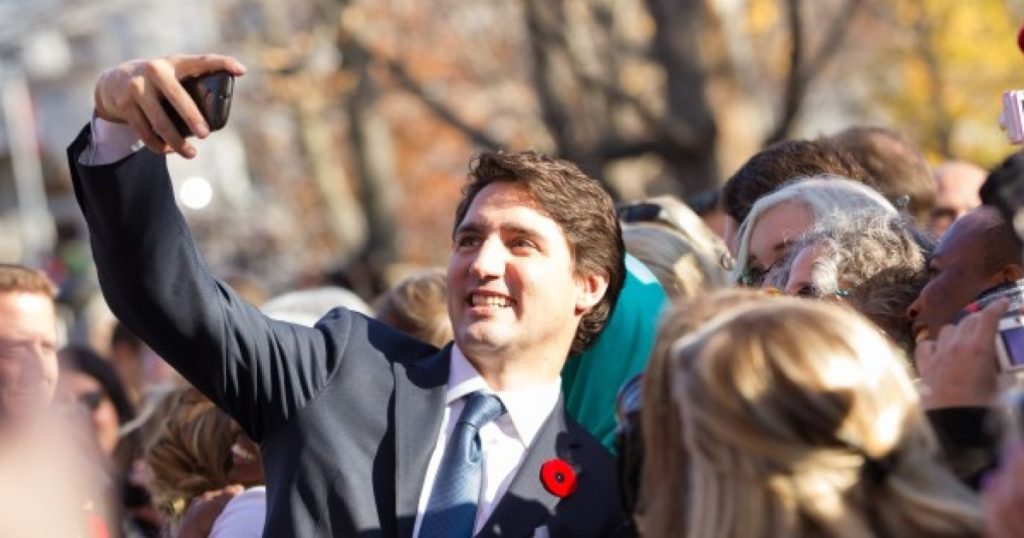 Prime Minister Justin Trudeau takes a selfie. The PM is responsible for appointing and shuffling cabinet ministers at his discretion, and they serve at his pleasure. Trudeau has delegated more authority to his ministers than any PM since his father. That he would be accused of overriding, directing, influencing or pressuring a minister of his Cabinet, and the Attorney General in particular, must indeed be a bitter pill for him to swallow.
And with all the accusations by the G&M, opposition calls to bring in the RCMP, pundits demanding the PM resign, is there little wonder that the smile has departed from even this PM’s face. So anyone wanting a selfie might want to keep that thought until the Globe and Mail prints a retraction of the story.
 Ray Rivers writes weekly on both federal and provincial politics, applying his more than 25 years as a federal bureaucrat to his thinking. Rivers was a candidate for provincial office in Burlington where he ran against Cam Jackson in 1995, the year Mike Harris and the Common Sense Revolution swept the province. He developed the current policy process for the Ontario Liberal Party. Ray Rivers writes weekly on both federal and provincial politics, applying his more than 25 years as a federal bureaucrat to his thinking. Rivers was a candidate for provincial office in Burlington where he ran against Cam Jackson in 1995, the year Mike Harris and the Common Sense Revolution swept the province. He developed the current policy process for the Ontario Liberal Party.
Background links:
Justice Committee Analysis – PM’s Discretion –
Wilson- Raybould – More Reasons Why – SNC Legal Options –
Shawcross Rule – Wilson-Raybould Future –
Understanding Jody – Butts –
Indigenous Issues – Cabinet Secrets –

 By Roland Tanner By Roland Tanner
February 23, 2019
BURLINGTON, ON
If the new 29 storey proposal for Lakeshore and Pearl is ultimately approved at the Local Planning Appeals Tribunal (LPAT), and forced on Burlington in a form anything like this first proposal, ECoB Engaged Citizens of Burlington, believes we are seeing an Ontario-wide collapse in the ability of municipalities to govern their own planning and development.
The public meeting held for the Carriage Gate development at 2069-2079 Lakeshore Road and 383-385 Pearl Street on January 29th was one of the most heated yet held in Burlington. Over two hours, residents at a packed Art Gallery of Burlington submitted the numerous objections and reservations they had with the proposed 29 storey development. No citizen spoke in favour of the development.
While ECoB continues to stress that it does not oppose reasonable development or intensification, it absolutely believes developers have an obligation to work within the in-force and provincially-approved planning context established by democratically elected councils.
Residents have recently expressed their preferences in unambiguous terms about over-development in downtown. It is therefore dismaying to see proposals coming to City Hall at a rapid rate which don’t just exceed planning maximums, but completely ignore the entire planning context that Council has established over the last decade and a half.
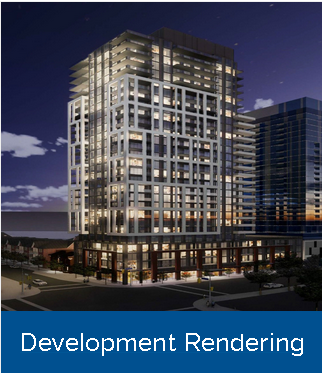 This new proposal from Carriage Gate (the developer behind the 421 Brant St development which led to the creation of ECoB) suggests a level of massing, setbacks and overall height that massively exceeds both the in force Official Plan and the ‘Grow Bold’ Official Plan introduced by the last council. Regardless of one’s opinions at the 2018 municipal election, this development completely disregards all attempts by Council to moderate development downtown. This new proposal from Carriage Gate (the developer behind the 421 Brant St development which led to the creation of ECoB) suggests a level of massing, setbacks and overall height that massively exceeds both the in force Official Plan and the ‘Grow Bold’ Official Plan introduced by the last council. Regardless of one’s opinions at the 2018 municipal election, this development completely disregards all attempts by Council to moderate development downtown.
Here are just some of the concerns raised by residents, which, according to how the planning process is intended to work, should be addressed before this proposal comes to council for approval.
Increase on already excessive ground-level windspeeds on Lakeshore/Pearl
Loss of commercial space.
Lack of justification for exceeding proposed Official Plan by 12 storeys.
Traffic impact.
Dramatically lower parking provision than required by by-laws.
Need for City Planning Department to respond in time on all applications to avoid automatic appeals.
Practicalities of reversing delivery and garbage trucks.
Lack of respect for residents in proposals which ignore all City Planning objectives and maximums.
Need for 3-D models
Need for any Chapter 37 benefits to be honoured and not reneged on.
Possibility of impact of failure to provide Chapter 37 benefits promised on other developments.
 Pearl Street Cafe was a recent Carnacelli property acquisition – part of a small land assembly that reaches down to Lakeshore Road. ECoB believes this proposal is the most obvious case yet of over-development in downtown Burlington. While we hope, and aspire, to work collaboratively with developers to make their proposals align better with residents’ objectives, there seems little way in which this development, even if scaled dramatically back, would reflect the democratically expressed preferences of the residents of Burlington.
We believe this development is likely to be a test case, not just for the new council, but for the role of municipalities and local democracy in Ontario. The outcome will tell us much about the power of municipalities versus the power of developers to demand, and receive, approval for developments which bear no relation to legally adopted and provincially endorsed Official Plans.
Roland Tanner is an academic, a community activist, a member of the Shape Burlington Report committee and a candidate in the last municipal election. He is also vice chair of ECoB and has a very dry sense of humour

 By Pepper Parr By Pepper Parr
February 22nd, 2019
BURLINGTON, ON
The Gazette keeps hearing about problems at the Seniors’ Centre on New Street. For the most part they are small niggling little issues but when collected together they suggest there is a deeper issue.
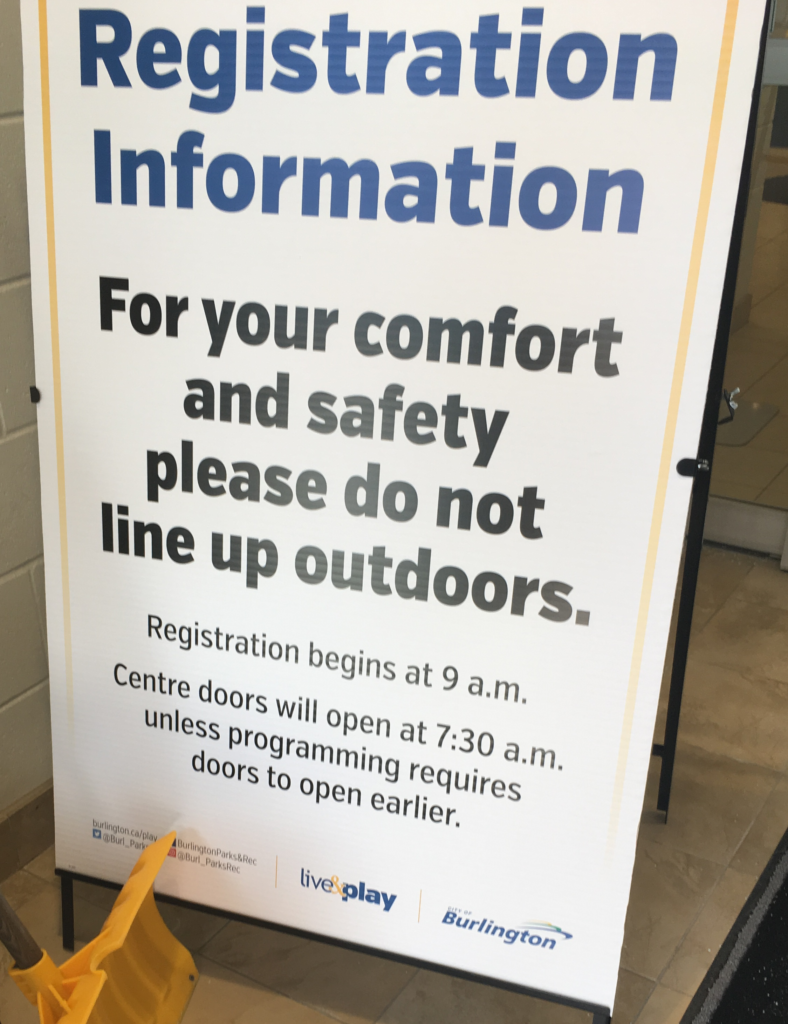 Seniors’ Centre staff showing their concern for the comfort and safety of people who use the facility. Do the staff really care about the people they are supposed to be serving?
These are seniors; the people who have paid their dues and have the right to quality time and more than just a measure of dignity.
The week was registration week – the Gazette published a news report on some of the problems that were being experienced with the registration process and the impact a change in the way programs are paid for was having on some people.
Earlier today we were sent a photograph of a sign that had been set up outside the entrance door advising: For your comfort and safety please do not line up outdoors.
The doors should be opened as early as possible so that the seniors can be both safe and comfortable.
There is a care taker in the building – he could unlock the doors and people could wait in the auditorium.
People get to the Centre as early as possible so they can obtain a number and be in the registration line based on the number they hold. These people want to take courses – many of them that are exercise classes. They want to remain healthy and active – but the staff seem to want them to stand out in the cold.
Burlington is a city that talks about the way it cares for its citizens but refuses to open the doors to a public building so that older people can get inside and stay out of the chilly if not downright cold weather.
What is wrong with these people?
Related news story:
Empathy appears to be in short supply as Seniors’ Centre

“First I want to say these allegations are false. Categorically untrue. Every one of them.” (Patrick Brown, CTV News- January 24, 2019)
 By Ray Rivers By Ray Rivers
February 20th, 2019
BURLINGTON, ON
Part 4 of a four part article
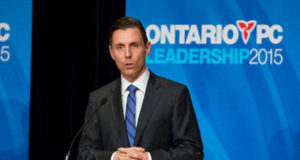 Patrick Brown is made leader of the Progressive Party. Sir Isaac Newton taught us that what goes up must come down. But that doesn’t always mean the faster you climb up the political ladder the faster you’ll tumble down. Though it did for Patrick Brown, if being ‘down’ includes ending up as mayor of the sizeable city of Brampton, instead of premier.
Over a year has passed now since Brown was forced out as Ontario PC leader. And if, as he contends, this was a political assassination by his own party, the question is why nobody but me is talking about it. The entire issue has virtually disappeared from the mainstream news. Perhaps it’s because the PCs are able to do a better job of changing the message than their Liberal colleagues. So maybe we’ve got this pro-liberal media bias thing wrong.
Just look at how a single speculative allegation in the Globe and Mail, about the prime minister’s office and the federal Attorney General (AG), has led to resignations, including that of the second most powerful person in Justin Trudeau’s government – Gerald Butts.
News is what’s in the newspapers. But there is zero evidence that anything illegal or even improper happened. Denials abound of direction-given and pressure-applied to the AG, and SNC is still going to court rather than getting its plea bargain. The only story here is how the media and opposition parties are colluding to ruin Trudeau’s chances in the upcoming election.
 Brown being chased by media after announcing his resignation as leader of the Progressive Conservative Party. There are troubling similarities with regard to the CTV report which ended Brown’s leadership of the Ontario Progressive Conservative party. The allegations that Brown, the teetotaler, had plied an under aged girl with booze for sex were false on at least a couple of counts. For one thing the girl wasn’t underage and she admitted that the sex had been consensual. It was an inaccurate story which the network retracted, amended, and corrected; and over which Brown is now suing them for eight million big ones.
If this wasn’t a total conspiracy it sure looked, smelled and behaved like it. No sooner had the CTV story broken than Brown’s key caucus members convened for a conference call, without Brown. And when Brown finally got wind of the call and joined in, they had one message for him – just resign and now. They weren’t interested in his side or the story. They had the smoking gun so who needed to wait for the finger prints to come back from the lab.
Then there were the staff resignations, almost on cue in a perfectly orchestrated pincer movement – the perfect trifecta for an almost instantaneous bring down. His three top advisors led the stampede with…“Earlier today, all three of us became aware of allegations about Patrick Brown. After speaking with him, our advice was that he should resign as Ontario PC Party leader. He did not accept that advice.”
 Alykhan Velshi, Brown’s chief of staff is a brilliant 30-something lawyer and policy analyst with credentials from the London School of Economics. He spent his formative years developing his skills as a neoconservative, first at the American Enterprise Institute and the Foundation for the Defence of Democracies, then as a political operative in the government of former PM Stephen Harper. Alykhan Velshi, Brown’s chief of staff is a brilliant 30-something lawyer and policy analyst with credentials from the London School of Economics. He spent his formative years developing his skills as a neoconservative, first at the American Enterprise Institute and the Foundation for the Defence of Democracies, then as a political operative in the government of former PM Stephen Harper.
Velshi has an impressive political resume, working in Harper’s office and also advising ministers John Baird and Jason Kenny. In fact Brown had hired him on the strength of his time with Kenny. And Brown should have known that was going to be trouble. Kenny, the ultra-conservative, and Brown, the political centrist, never saw eye to eye, particularly after Kenny virtually blackmailed the MP Brown into voting against his will on an issue.
And Velshi is as far right wing politically as Brown is firmly in the center of today’s political world. Velshi had been responsible for developing the Tory opposition strategy to Liberal leader Stephane Dion’s ‘Green Tax Shift’ carbon tax proposal back in the mid 2000’s. How was he now supposed to get behind Brown’s policy of implementing a comparable carbon tax?
But Velshi swore up and down that he was on-side with fighting climate change and a carbon tax. That would have been a 180 degree turnaround from his earlier days peddling fellow ultra rightist Ezra Levant’s oxymoronic notion of ‘ethical oil’. But he was not the only obviously disingenuous Tory signing onto Brown’s policies.
 In fact almost all of caucus officially supported Brown’s ‘People’s Guarantee” which was endorsed at the party’s November 2017 policy conference. Though Velshi’s previous mentor, Albertan Jason Kenny, stormed out of the conference once he realized that a carbon tax was one of those policies. In fact almost all of caucus officially supported Brown’s ‘People’s Guarantee” which was endorsed at the party’s November 2017 policy conference. Though Velshi’s previous mentor, Albertan Jason Kenny, stormed out of the conference once he realized that a carbon tax was one of those policies.
There is no more reasonable explanation for what happened to Brown than the way he himself penned it in his book. If it wasn’t a set up, then we’ve all been watching too much TV, or too little. This was a perfect trifecta: mutineer-minded staff, a treacherous caucus and a damning news story.
Almost immediately after the CTV report Brown became a toxic commodity – an outcast ironically from the very party he had restored out of the ruins left him by former leader Tim Hudak. Brown was eventually evicted from caucus, disallowed candidacy to run again as MPP, and even refused the opportunity to run for Chair of Peel Region after Ford cancelled that election. Kathleen Wynne had been treated better.
Brown’s book may help identify the ‘how and why’, but it might take another book to identify the ‘who’ – who were the actual manipulators of this conspiracy. Doug Ford ended up the big winner – he wasn’t even in caucus back then. Carolyn Mulroney picked up some of his staff, but lost her bid anyway in the leadership campaign. And pretenders to the throne, Vic Fedeli and Christine Elliott, were left just out of the winners circle once again.
Brown’s former chief man Alykhan got his old job back working for interim leader, Vic Fedeli, until the provincial election when he got himself sweet-hearted into a plum job at Ontario Power Generation. Except that, in a puzzling move, Ford’s own chief of staff indirectly fired Alykhan before he’d even sat down at his new desk.
Perhaps, like the Mafia, the Ontario PCs like to bury the bodies of their worn out operatives themselves. And on that count , despite the law suits, this whole affair was just an internal thing, a PC family matter.
Maybe that is the real reason why it’s not in the news anymore?
Background material:
Brown Denial – Insane Month – Brown Defence Statement –
Brown’s Book – Ethical Oil – Alykhan Velshi –
Fired from OPG
 Ray Rivers writes weekly on both federal and provincial politics, applying his more than 25 years as a federal bureaucrat to his thinking. Rivers was a candidate for provincial office in Burlington where he ran against Cam Jackson in 1995, the year Mike Harris and the Common Sense Revolution swept the province. He developed the current policy process for the Ontario Liberal Party. Ray Rivers writes weekly on both federal and provincial politics, applying his more than 25 years as a federal bureaucrat to his thinking. Rivers was a candidate for provincial office in Burlington where he ran against Cam Jackson in 1995, the year Mike Harris and the Common Sense Revolution swept the province. He developed the current policy process for the Ontario Liberal Party.
Previous parts of the four part article.
The political take down of Patrick Brown – Part 1
Rivers on Patrick Brown – He said – she said – Part 2
Rivers on Patrick Brown – Part 3

 By Jim Young By Jim Young
February 18th, 2019
BURLINGTON, ON
In recent Gazette articles and comments, Burlington’s 25 Year Strategic Plan, “Grow Bold”, has garnered much criticism of its name and the plausibility of a vague plan that looks 25 years ahead.
 Grow Bold got the boot – the Mayor had to almost push it out the door. The name really doesn’t matter. Call it Grow Bold, Grow Smart or just The 25 Year Plan; having a plan is important. To achieve anything of consequence we need a longer term view of how our city might look in 25 years. That view is necessarily vague and aspirational; who really knows where we will be by then?
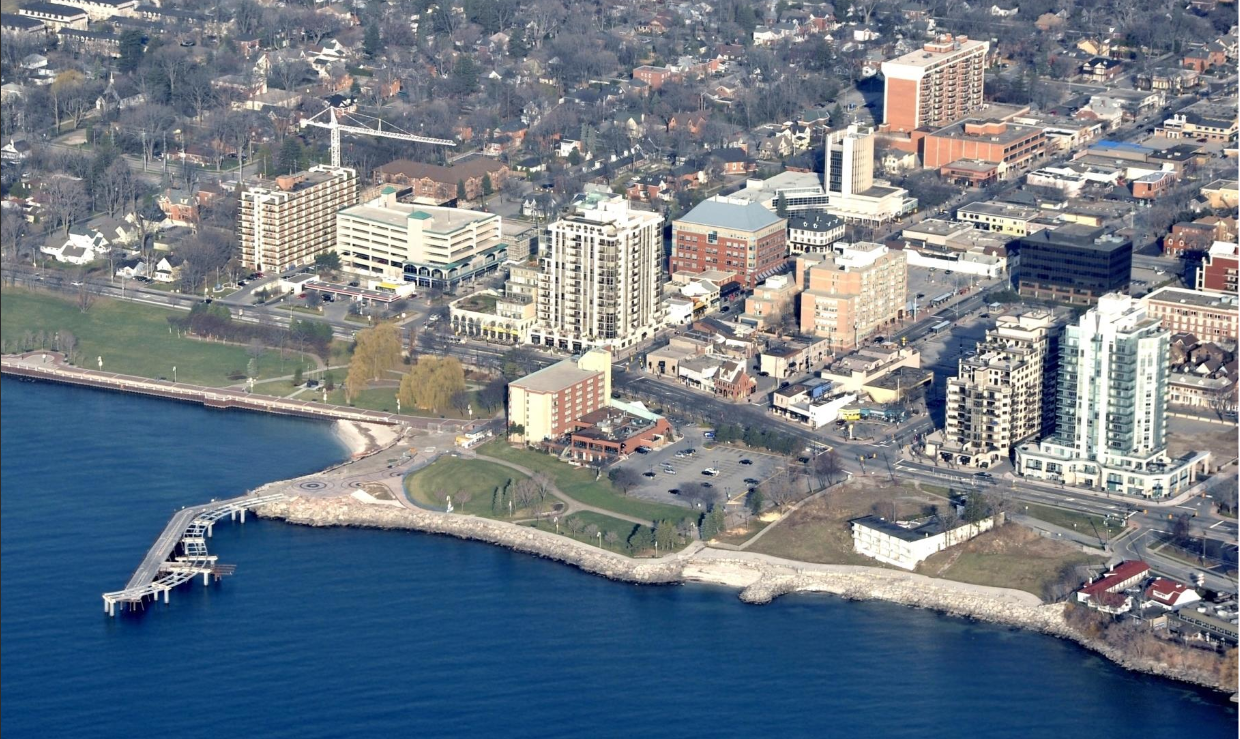 This aerial of the city is going to look a lot different in five years – in a decade you won’t recognize the place, A personal analogy might be a 40 year old planning to retire at 65. How will that retirement look in 25 years? Do I want to travel? Spend time with grandkids? How will I pay my rent? Will I have to keep working? Of course these possibilities may change over the 25 years, but we still need to plan for them. You cannot drive to Florida if your GPS is only programmed to the end of the street. Unless we are extremely lucky, little in life is achieved without a plan. Call this our “Retirement Strategic Plan.”
 The creation of the 2010 -2014 Strategic Plan was a city staff – city council effort that then went to the public. They filled pages of flip chart work but found at the end of the sessions that city staff and council were on different sides of a fence. It was that way for the term and the one that followed. Then we need more specific details: How much should we save and where will that money come from. Will it be RRSPs? Tax Free Savings? Is there a Company Pension? Can I live in my kid’s basement if my Retirement Strategic Plan doesn’t work? This is the meat & potatoes of our planning. Call it our Retirement Official Plan.
Then come the bumps on the road to retirement. When we run into car repairs or the basement floods, when we face short time work or job loss: Changes we must make to our plans. “Amendments to The Retirement Official Plan.” Doubtless we will have contentious domestic debate about these.
Municipalities need plans too. City planners work on at least three levels, with many sub levels in between. The Strategic Plan, The Official Plan and Zoning / Bylaw Amendments to those plans.
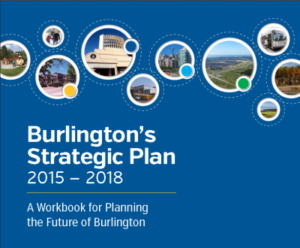 It started out as a four year plan – the term of a city council …. The Strategic Plan: A long term, aspirational view of where we might like to be in 25 years. Obviously no-one really knows where we will be by then; but we must have an idea of how we want our city to evolve over that period. This is the one plan that Burlington consulted citizens on and actually did a reasonable job on.
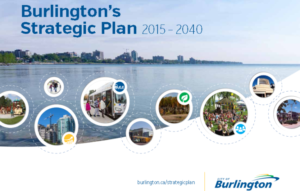 … and just sort of grew when a consuklting firm with the compliance of the then city manager took council in a much different direction. The Official Plan; a detailed and much more pertinent document, sets out the steps needed to realize the strategic vision. Mandated by the province for regular review, it re-evaluates the plan to adjust for economic, social, demographic and political shifts that may not be foreseeable but will inevitably take place over 25 years.
This is the plan that should have defined the transit, parking, congestion, intensification plans and area/zone specific heights as they evolved over the next 5 years of that 25 year strategy. Sadly our last City Council failed to provide an Official Plan that met regional requirements and utterly misjudged local sentiment on every level.
Outraged citizens vented their anger in wholesale changes at the last election.
Lastly there are Amendments to the Official Plan and the Zoning Bylaws of that plan. These are often the most contentious and time consuming aspects of city planning. Amendments address those changes to residential, commercial and retail building in our neighbourhoods, which have greatest impact on life and work in our communities.
No matter what the Strategic or Official Plans say about height and density on your street or the plaza at the end of the block, developers can apply to amend the plan or zoning bylaw. These are the matters that are currently the most contentious in our city.
Subject to a 210 day deadline for response by municipalities, there are so many zoning / bylaw amendments active in Burlington that city planners are failing to respond to them in time, opening the door to so many appeals by developers.
These are not failures of the strategic plan. They are failures of process, of consultation and, of course, they must be addressed. In its early actions Council has demonstrated a willingness to address these issues and already there is a feeling that city staff are adapting to this new council paradigm.
We can and should oppose bad planning, we deserve greater say in the plans and the processes, but instead of abandoning the discipline of Strategic Planning, let us work with our new council and city planners to make these plans better. Let us align city plans with citizen visions rather than developer bottom lines in the knowledge that the only thing worse than a Vague Long Term Plan is No Long Term Plan At All.
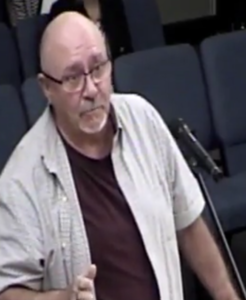 Jim Young delegating at city hall. Jim Young is an Aldershot resident who delegates at city Council frequently and has, in a number of cases, given some very wise advice. It was seldom received with much in the way of grace by the 2010 to 2018 city council

 By Ray Rivers By Ray Rivers
February 13th, 2019
BURLINGTON, ON
The Globe and Mail gets the prize for turning what might have been a relatively peaceful run-up to this October’s federal election into an exciting game of gotcha. Everyone is waiting to hear from Canada’s former Attorney General, Jody Wilson-Raybould, who has remained silent to this point but is clearly stirring the pot.
 No one really knows what happened – at some point Jody-Wilson-Raybould will have something to say and it will reverberate. Having hired a heavy hitting legal beagle to represent her, it is only a matter of time until she starts singing publicly about what has been going on. Though that has not stopped just about everyone, least of all the politico’s, from heavily debating and already passing judgement.
If the Globe is right, this is about a decade-old bribe which SNC Lavalin paid Libyan dictator Gaddafi’s family in order to build public works there. Bribery and corruption are illegal for Canadian companies even if they do it off shore. The SNC executives responsible have all left the company, one had served time in a Swiss jail, and the company itself has been banned from obtaining UN contracts for a decade.
Quebec based Lavalin is one of the top-ranked engineering design firms in the world with operations in over 160 countries and employing thousands in Canada. Its operations cover the field from primary to service sector consulting and engineering services, including the Candu Energy nuclear reactor division, which it acquired from Atomic Energy Canada several years ago.
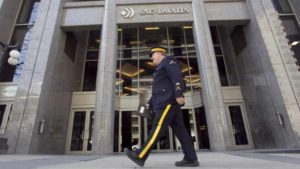 SNC Lavalin – has been a problem corporation for some time but always a big big hitter in Quebec. Last fall Deferred Prosecution Agreements (DPA) were made law in Canada, bringing us in line with US and UK corporate wrong doing legislation. A DPA, which has been under development for a while, is essentially a plea bargain whereby the guilty party acknowledges their wrong doing, pays a hefty fine and promises to be good from now on. And most importantly for everyone, it avoids a costly and uncertain trial.
We have been led to believe from the Globe articles that Kathleen Roussel, Canada’s director of public prosecutions wanted to take SNC to trial regardless of the DPA. And further that AG Wilson-Raybould was standing by her director of prosecutions. But the prime minister’s office or somebody else was pressuring the AG to change her stand and her mind.
 In better days – they were made for each other. The PM claims that neither he nor his office ever directed the AG to go the DPA route and that he had told Wilson-Rayboult these kinds of decisions were hers and hers only. But then she was moved out of the AG position at the last Cabinet shuffle and given a lesser portfolio.
All of this leaves more questions than answers:
1. If he had every confidence in his AG, why did Trudeau shuffle her?
2. If he just wanted to shuffle his Cabinet, why send her to Veterans’ Affairs, which is considered a demotion?
3. Shouldn’t Trudeau have been prepared for disappointment and even hostility from his former AG for demoting her?
4. Wilson-Rayboult would have been instrumental in drafting the DPA, why didn’t she support it rather than a trial for the SNC case?
5. If it wasn’t the PM, who in the PMO was pressuring the former AG?
6. Was SNC-Lavalin also involved in pressuring the AG?
7. Clearly this issue would have been discussed extensively in Cabinet and among the PM and AG’s advisors – if she felt she couldn’t do what was right, why didn’t she resign then as AG, rather than now?
8. As AG, a powerful Cabinet position, why didn’t she just stand her ground – or at least have the conversation with the PM he said he was open to?
9. Who leaked the story to the Globe and if it was the former AG, wasn’t she breaching Cabinet secrecy and also breaking the law?
This story is far from over but everyone needs to keep their gun powder dry (for the firing squad) until there are some answers to these questions. I will be following up on this story in due course.
 Ray Rivers writes regularly on both federal and provincial politics, applying his more than 25 years as a federal bureaucrat to his thinking. Rivers was once a candidate for provincial office in Burlington. He was the founder of the Burlington citizen committee on sustainability at a time when climate warming was a hotly debated subject. Ray has a post graduate degree in economics that he earned at the University of Ottawa. Tweet @rayzrivers Ray Rivers writes regularly on both federal and provincial politics, applying his more than 25 years as a federal bureaucrat to his thinking. Rivers was once a candidate for provincial office in Burlington. He was the founder of the Burlington citizen committee on sustainability at a time when climate warming was a hotly debated subject. Ray has a post graduate degree in economics that he earned at the University of Ottawa. Tweet @rayzrivers
Background links:
Lavalin – DPA – Lavalin Other Crimes –
Lavalin Background – AG Talks – MacLeans Story –

 By Gary Scobie By Gary Scobie
February 13th, 2019
BURLINGTON, ON
I am a citizen of Burlington who has taken an interest in the re-development of Burlington’s downtown, delegating at numerous Planning and Development Meetings and City Council Meetings in opposition to the over-intensification of Burlington, particularly our downtown.
I wish to participate in this LPAT appeal, speaking in opposition to the appeal by Reserve Properties Ltd. I have no direct pecuniary interest in this development. My written submission follows.
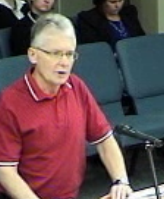 Gary Scobie I have delegated at City Hall on this development proposal, on the 421 Brant Street proposal (now approved), on the 374 Martha Street proposal (now approved) and on Burlington’s new Official Plan (unapproved), so I have a history of engaging in development matters in Burlington. I am fully aware of the Places to Grow, Greenbelt and Metrolinx legislation in Ontario and the desire to intensify Southern Ontario municipalities, reduce urban sprawl and protect our natural and agricultural greenbelt.
I understand the minimum density targets assigned to areas designated as Urban Growth Centres and Mobility Hubs. I also understand that there are no building upper height regulations in Provincial legislation. Building height upper limit is left to municipalities and their zoning regulations. Thus municipalities have the obligation and the right to define how they will meet Provincial people/jobs density targets and where high buildings should best be situated to add to density while preserving the urban character and living environment for citizens.
I do take issue with the Provincial designation of Downtown Burlington as an Urban Growth Centre and the Metrolinx designation of the Downtown Burlington Transit Terminal as an Anchor Mobility Hub. They each bring density targets to our downtown that I feel are excessive. I believe that our new City Council will be debating the merits and validity of these designations and consulting with the Province on the ability to move the Urban Growth Centre elsewhere in Burlington and un-designate the Anchor Mobility Hub. I will reference these two issues further in my submission.
I will also reference our new unapproved Official Plan and how it has been used by developers and our former City Council to gain inappropriate building heights downtown while violating our current approved Official Plan. Our new City Council will also be debating amendments to limit height in this unapproved plan before sending it back to Halton Region for approval.
In actual fact, this appeal is not inconsistent with a Provincial Policy Statement and does not fail to conform to a provincial plan. But that is in itself a real problem. The policy statements and plans of the Province place no upper limits on building heights, so when the sky is the limit then there can be no violation or lack of conformity by a developer’s application that involves high rises. With no limits on height, no building adding density in a designated urban area would ever fail a provincial mandate or target. The density targets, whether within a Mobility Hub or Urban Growth Centre or not, can usually be met with mid-rise buildings. But developers like high rise buildings because their motivation is profit rather than public good. Public good (or bad) is just a by-product of the constructed building.
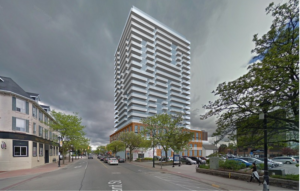 What a develop wants to build on the south side of James Street on Brant will dwarf city hall even further. Gary Scobie spoke at the LPAT meeting which is hearing an appeal of the 17 storey’s the city approved for the site – the developer wants 24 storeys. Developers can dress their proposals up to look and sound pretty nice and say that the Province is demanding that they build high rises, but that is not true. The Province is simply asking municipalities to build to an area density target, not a site specific one. And yes, the target can be exceeded, but it is not mandated. My understanding is that most cities are well short of their assigned area targets, unlike Downtown Burlington which will reach its Urban Growth Centre Target well ahead of time. And there are no announced penalties for cities that do not meet target. So the Province’s targets are just that; targets that have no teeth behind them and leave the real work to the municipalities to figure it all out. I ask the Tribunal to let the City of Burlington do just that.
Let me use an analogy to make a point. Pretend we’re in a very small room that has a grid pattern of downtown streets on the floor, with electrical connections running along each street. The Province says heat the lower half of the room to a certain average temperature. Developers suggest that 150 watt incandescent light bulbs at most corners should do it. They each produce a lot of heat as a by-product of lighting them. But this creates high heat just at each location, while other parts of the room stay cool. It is inefficient, but it does eventually bring the average temperature up, but with hot areas at street corners and cool areas elsewhere. The average temperature is likely felt by no one.
 How many light bulbs will it take for the decision makers to see the light? The Planning Department and Council have a better idea. Use 40 and 60 watt incandescent bulbs not just at corners but also along some more of the downtown streets, so heat buildup at each bulb location is less, but more bulbs spread this lower localized heat around much more efficiently to bring the same average temperature as the developers’ solution, but spread more evenly across the downtown so more people actually feel the average temperature.
In real life, the 150 watt bulbs are high rises. The 40 watt bulbs are low rises to 4 storeys. The 60 watt bulbs are mid rises to 11 storeys. High rises concentrate people, parking and traffic congestion, shadowing and wind effect in high degrees at major corners. Low and mid rise buildings concentrate fewer people per building across a greater spread of the downtown, so congestion for traffic and parking is lessened because it is spread out in the wider area. There would be less shadowing and wind effect from lower buildings. The ability to fight a fire in such lower buildings would be much easier than to fight a high rise fire, lessening the danger to tenants. Both solutions can reach an area target, but the low to mid rise solution does it in a kinder and gentler way, without packing in hundreds of people in small ground area sites soaring to great heights just to give us a new skyline.
Of course neither solution would have to be considered if our downtown was freed from Urban Growth Centre and Anchor Mobility Hub designations and their growth targets.
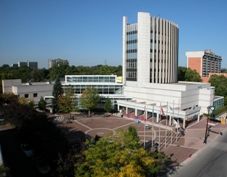 Quite where the city hall fits into the longer term development picture is not at all clear. There is a report in a file outlining what might be possible. Getting back to this proposal, to build to match the height of the tower across the road (421 Brant Street) is simply using as a precedent a poor decision by our former City Council to over-reach in height its own current and proposed Official Plans, against the public outcry and the public good. The idea of the twin towers as a gateway to our iconic eight storey City Hall and its adjacent Civic Square is one great marketing scheme, but fails as suitable to this location. I believe it fails as suitable in any location in Burlington. A gateway is usually a structure far lower in height than 23 storeys. And no gateway is required to our City Hall. The approach along New Street, then James Street is a grand enough gateway.
I ask the Tribunal to keep in mind that the new City Council may succeed in removing the Urban Growth Centre and the Anchor Mobility Hub from the downtown, making a mockery of any claim that we must build this tall building here or anywhere downtown to conform to provincial policy and plan. The old Council assured citizens that no new single building creates a precedent. Yet developers seek to use precedent as a reason to build ever-higher (and in this case near twin) buildings and the OMB has in the past let precedent seep into decision-making. I request that the LPAT not be influenced by precedent-based arguments from developers. Using bad precedents will only produce a worse future.
The Urban Growth Centre can be moved by a municipality – Oakville did so in 2005. An Anchor Mobility Hub is required to have a dedicated rapid light rail connection with a Gateway Mobility Hub. There are no plans for an above-ground or subway rapid transit linkage connecting the Transit Terminal to the Burlington GO Station. Thus, it does not qualify as a valid Anchor Mobility Hub.
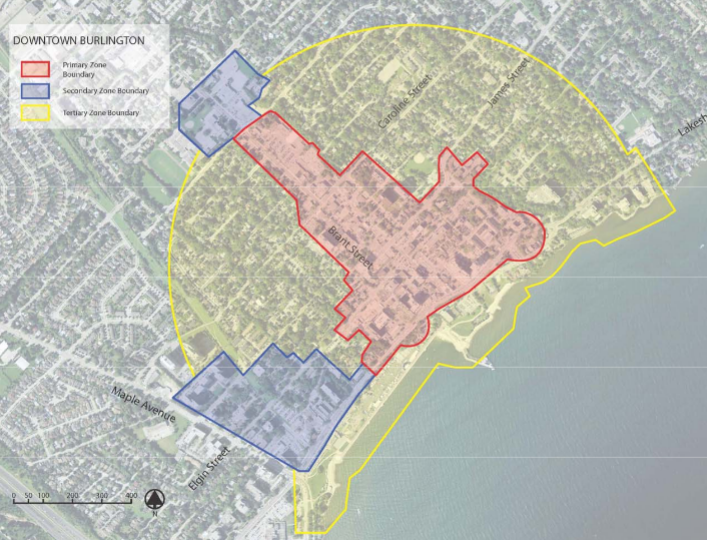 Boundaries set out for the Downtown mobility hub. Scobie argues that the criteria for a hub don’t exist.
Now to the factual reason that the Tribunal should deny this appeal and in fact, if within its power, reduce the height to a mid-rise limit. Our new Mayor, as Councillor for the Downtown in the previous Council, proved that we were on target in moving toward the 2031 density numbers with the current Official Plan and advocated for an easing of height limits that were proposed in the new Official Plan. With a new Council in place, with a majority of members who were elected advocating for such an easing, I am confident that they will support the Mayor in her advocacy for reasonable height downtown.The appeal height request and the previous Council decision to award 17 storeys height both fly in the face of the current approved Official Plan which designates a 4 storey height, moving to 8 storeys with negotiated community benefits. As do the density numbers which are proposed by the developer at 1135 units per hectare.
If we use a conservative average of 2 people/jobs per unit, this would translate to 2270 people/jobs per hectare, where the current Official Plan would allow up to an 8 storey building, roughly one-third as high and therefore holding approximately 700 people/jobs per hectare, still fairly dense and helping move toward the area target of 200 people/jobs per hectare of an Urban Growth Centre.
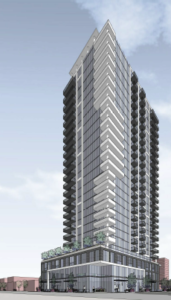 Opposite city hall on north side of James  Opposite city hall on the south side of James. Developer wants same height as the other side of the street 24 storeys – city approved 17 storeys. An eight storey building on this site would aid the target and impose a much less imposing structure on this neighbourhood. It would be a model to replicate in other downtown core locations that the Planning Department and City Council deem suitable to intensification toward target. It would also agree with the current Official Plan. These are reasons enough to turn down the appeal by the developer and allow the City to decide on height in the downtown core that is more in line with citizen wishes. If possible, I would recommend that the Local Planning Appeal Tribunal not only do this, but rule to uphold current City Zoning at this site if it is within its power.
This appeal is clearly in violation of the Official Plan of our municipality. The past poor decisions of City Council and the OMB on excessive intensification in our downtown cannot be undone, but they can serve as learning experiences to help guide our planning in the future to increase density, in a way that helps our downtown maintain its character and attraction without the over-congestion that comes with high rise after high rise appearing at each major corner and section assembled by developers.
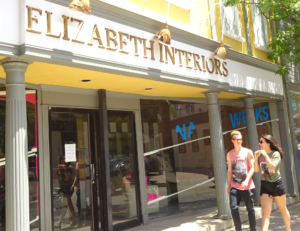 The former retail location is empty – developer has been given approval for 17 storeys – has appealed to allow 24 storeys. 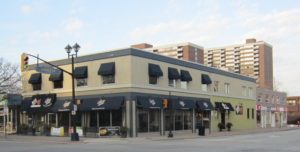 Once a popular restaurant location – it will be redeveloped and become a 24 story condominium. The history of treating each high rise application as a one-off decision in isolation without looking at future ramifications of the cumulative effect of successive high rise applications in a small area should end here. I’m asking the LPAT to consider this issue and support our municipality in its quest to grow its density in its own way, by rendering a decision that will promote this.

 By Pepper Parr By Pepper Parr
February 11th, 2019
BURLINGTON, ON
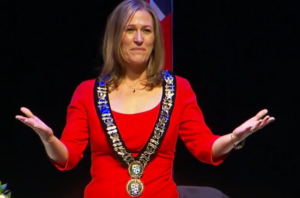 With power in her hands – Mayor Meed Ward has an opportunity to really lead. When newly elected Burlington Mayor Marianne Meed Ward had the Chain of Office placed around her neck on December 3rd, she told the audience that she had some news she would release the following day.
The next day city hall announced the dismissal of city manager James Ridge.
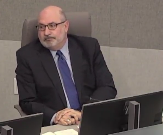 Interim city manager Tim Commisso. While there was a Deputy City Manager, this new city council wanted an experienced city manager in place and entered into a short term agreement with Tim Commisso to serve as an Interim City Manager for a period of six months and announced that council would begin the process of finding the next full time city manager
Burlington has gone through four city managers in an eight year time frame.
Former Mayor Rick Goldring dismissed Roman Martiuk. The city then hired Jeff Fielding who left the city of London to come to Burlington.
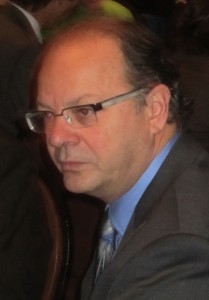 Former City manager Jeff Fielding did his best to significantly reorganize the senior levels at city hall. When a better offer came along he left. City staff needed time to get used to the energy and drive that Fielding brought to the city. After less than two years a head-hunter discovered Fielding and introduced him to Naheed Nenshi, Mayor of Calgary – those two were a match made in heaven.
Fielding resigned and the city was once again looking for a city manager. They brought in Pat Moyle, who was a retired CAO for the Region of Halton to Burlington.
Moyle saw the city through the August 2014 flood and kept the city on track while the search for the next city manager took place.
Council settled on James Ridge who came to Burlington from British Columbia. Ridge was a good fit for the Goldring council; – he wasn’t a fit for then ward 2 Councillor Marianne Meed Ward.
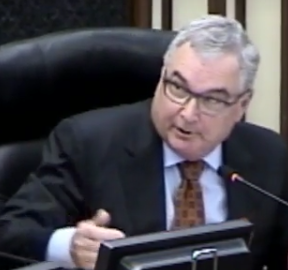 City manager |James Ridge defined his job as protecting his staff rather than holding them accountable. In one memorable memo he told staff that he “had their backs”. Ridge is reported to have told a person he knew well at city hall that if Meed Ward won he would not be the city manager for long. That proved to be true.
There has been no word yet on if there have been any meetings on what the process of looking for a new city manager will be.
In a detailed book on the Premiership of John Robarts, who was Premier from 1961 to 1971, Steve Paikin reports that in 1968 Robarts “created one of the most important advisory bodies in his entire premiership.”
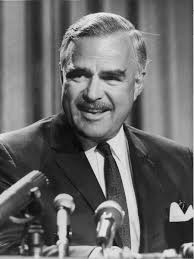 John Robarts – one of the best Premiers the province ever had. Robarts had been convinced that the province had grown to the point where it needed more qualified people in its senior ranks and created a Commission on Government Productivity that helped set the framework for an administration that has served the province exceptionally well.
The Commission wrote ten reports and lasted well beyond Robarts’ years as Premier. It submitted ten reports.
The Gazette is not suggesting that Meed Ward and her council create a commission that takes a decade and writes ten reports but she might want to give serious consideration to looking for outside advice on what the structure of a municipal government should – could look like in these changing times.
The last time any advice was given to Burlington’s city hall it didn’t get much in the way of a professional reception.
 The Shape Burlington report set out what was wrong with city hall and what was needed in the way of change. Written by John Boich and former Mayor Walter Mulkewich who were served by a board of advisors, Senior city hall staff at the time didn’t want the report published – that wish wasn’t granted – they then wanted some changes in the wording. The Shape Burlington report set out what was wrong with city hall and what was needed in the way of change. Written by John Boich and former Mayor Walter Mulkewich who were served by a board of advisors, Senior city hall staff at the time didn’t want the report published – that wish wasn’t granted – they then wanted some changes in the wording.
 John Boich – co-chair of the Shape Burlington Committee died in 2011 Asking the late John Boich to revise strongly held views was not a wise response. In terms of culture and the way city hall has chosen to serve the public that pays them – here hasn’t been much of a change. City managers have taken the view that their role is to protect their staff rather than consistently hold them accountable for the quality of the work they do.
It should be possible to find a consulting firm (not the one that foisted that 25 year Strategic Plan on the city), to do a comprehensive report in three months and then meet with council to expand on their views and recommendations.
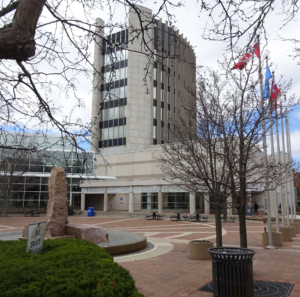 There is an opportunity to change the way city hall is currently organized – too many silos as well as significantly change the culture. Shape Burlington was the start. If the city is ever going to get to be run properly they might as well take the time to do it right. There are structural issues that need attention and there are cultural issues that need to be worked on.
Let us not make this a missed opportunity.
Salt with Pepper are the views,musings and opinions of the Gazette Publisher.

 By Ray Rivers By Ray Rivers
February 11th, 2019
BURLINGTON, ON
We’ve seen the numbers. Canadians spend almost $30 billion a year on some 600 million prescriptions. And we know we could save as much as $8 billion by transitioning to a universal nation-wide single-payer system. It’s a no-brainer, right?
 Tommy Douglas – advocating for universal health care. What would a universal program look like? It could be modeled on Canada’s universal health care system. In fact that would make it the perfect complement – administered by the provinces and funded jointly by both levels of government. The provinces already have a seniors’ drug program in place, and Ontario even had an OHIP+, covering those youth without a private health plan.
But to go that route, the provinces would have to agree among themselves on the universality and portability aspects. And they’d have to agree with the federal government on their joint responsibilities and cost sharing. That kind of deal might have been do-able back when the feds and most of the provinces shared a common political stripe, but with national partisan bickering increasing in the lead-up to the 2019 federal election, it won’t likely happen this year.
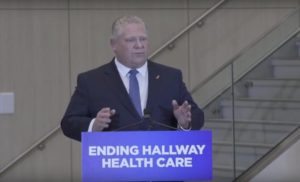 Doug Ford at the Joseph Brant Hospital For starters, Ontario, which is preoccupied with cutting or ending former Liberal programs has little interest in adding anything resembling a new or expanded social program, especially one which might lead to increased taxes. And cost-sharing discussions with a federal government currently being sued over carbon taxes is definitely a non-starter.
On the other hand there are good reasons for the federal government to implement a cross Canada program all on its own, given federal jurisdiction in the management of pharmaceuticals in this country.
One might expect the provinces to welcome a comprehensive program, funded at the federal level, saving them the costs of current provincial drug programs. But provinces are always wary about federal intrusion in what they see as their areas of responsibility, particularly in Quebec, so it’s not that easy.
How can we afford it? Well folks we are already paying the costs…and more. The existing patchwork of federal and provincial government subsidized programs is being funded through your tax dollars. On top of that, there is the cash we dole out at the pharmacy, the subscriptions to private drug plans, and the lower earnings accompanying a work place drug benefit. And that doesn’t count the costs to both the health system and work places for people who can’t afford to fill their prescriptions and end up just getting sicker.
It’s what we learned after moving to single-payer universal health care. We can’t afford not to have Pharma care. The four to eight billion dollar savings estimates may be speculative but it’s clear the savings won’t be zero. Efficiencies will be gained as competing pharmaceutical programs are reduced. Lower prices should be expected by negotiating for larger orders and buying in bulk. And then, of course, there is all that drug and drug insurance company profit.
 Profits for the pharmaceutical industry are among the highest in the world. Besides partisan politics at the provincial level, the other obstacle to implementation comes from lobbying by the Canadian patent drug industry and its international parents. They have become wary of efforts like Pharma care to compromise their profits in the nation with the highest drug prices on earth, after the USA. So they have offered to voluntarily hold the line on drug price increases over the next decade.
Their offer, which they estimate at $26 billion has been spurned by the federal government and for good reason. One has only to look at countries like New Zealand for inspiration. They manage to keep drug prices as low as one tenth of those here.
Pharma care was an integral part of Tommy Douglas’ vision for the nation’s first medicare program which he enacted In Saskatchewan. It was also a component of the original plan for universal national health coverage which the Pearson government introduced in 1964. The federal Liberals, in 1997, campaigned on a pledge to develop a plan for the implementation of universal Pharma care but failed to deliver.
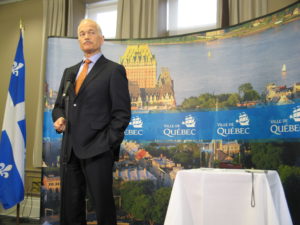 Jack Layton won almost everything in Quebec in the 2011 election. That let Stephen Harper form a government with the NDP serving at the Opposition. Only in 2004 had Paul Martin finally secured landmark inter-jurisdictional agreements for a number of social programs, including universal Pharma care. But dithering and being caught up managing fallout from the Liberal Sponsorship scandal took its toll. In 2006 Martin’s minority government fell thanks to Jack Layton’s NDP, and with it so did our hopes for universal Pharma care.
Stephen Harper wasted no time giving any more time to universal Pharma care. Tommy Douglas must have shuddered in his grave knowing that his own party had helped deprive Canadians of Pharma care for the next decade and a half. It was only last year that the Liberals announced setting up an advisory committee to plan for a national drug plan.
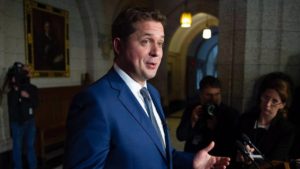 Scheer hasn’t had much to say on a universal health care plan. And Trudeau’s own finance minister mused that it might require means testing for income, thus ending dreams of universality. He clearly needs a primer on what the term Pharma care really means. And so does opposition leader Scheer, who, like Harper before him, has been mute on the idea, except for partisan attacks on the person leading the advisory committee.
And if Scheer wins the next election… there may well be somebody else writing this column in fifteen years and she’ll be asking … It’s a no-brainer, right?
 Ray Rivers writes weekly on both federal and provincial politics, applying his more than 25 years as a federal bureaucrat to his thinking. Rivers was a candidate for provincial office in Burlington where he ran against Cam Jackson in 1995, the year Mike Harris and the Common Sense Revolution swept the province. He developed the current policy process for the Ontario Liberal Party. Ray Rivers writes weekly on both federal and provincial politics, applying his more than 25 years as a federal bureaucrat to his thinking. Rivers was a candidate for provincial office in Burlington where he ran against Cam Jackson in 1995, the year Mike Harris and the Common Sense Revolution swept the province. He developed the current policy process for the Ontario Liberal Party.
Background links:
Global Pharmacare – Pharmacare – National Program –
Drug Prices Deal – Advisory Committee – Scheer –

 By Pepper Parr By Pepper Parr
February 7th, 2019
BURLINGTON, ON
 There has been a lot of confusion about just where Burlington is in terms of the provincial government Places to Grow policy. That is the program that sets out the longer term population growth plans. There has been a lot of confusion about just where Burlington is in terms of the provincial government Places to Grow policy. That is the program that sets out the longer term population growth plans.
The provincial government set the level to which population is expected to grow and determines where that growth should take place.
A population growth target is given to the Regional governments (they are called two tier set ups) and a number to the single tier government; Guelph and Toronto are single tier governments. Burlington. Oakville, Milton and Halton Hills are part of the Region – making us part of a two tier system.
Burlington’s Planning department has never offered anything firm on just what the city has in terms of population and what is expected in the short term future. The planners just kept saying we are guided by the Places to Grow policy. The developers would claim that their development was part of reaching the Places to Grow target.
Many thought the target had already been met. The then Councillor Marianne Meed Ward kept saying the target for 2031 was being met and that we were in fact ahead of the requirement.
The target for 2041 is known at the Regional level – Burlington doesn’t know what its share of that number is going to be.
Much of the development in the downtown core is being driven by that Places to Grow policy.
Gary Scobie, a retired Burlington resident and frequent effective delegator, did some homework and came up with some numbers that suggest Meed Ward was right – we have reached our 2031 target or are so close that with the developments in the pipeline the city will reach its target handily.
Here is what Scobie had to say in his Growth Targets 101 presentation.
The Urban Growth Centre is where the development is taking place.
The Urban Growth Centre is shown with a red dotted line that is sometimes a solid red line. It extends as far north as Prospect Street. Total area is 104.6 hectares (ha)
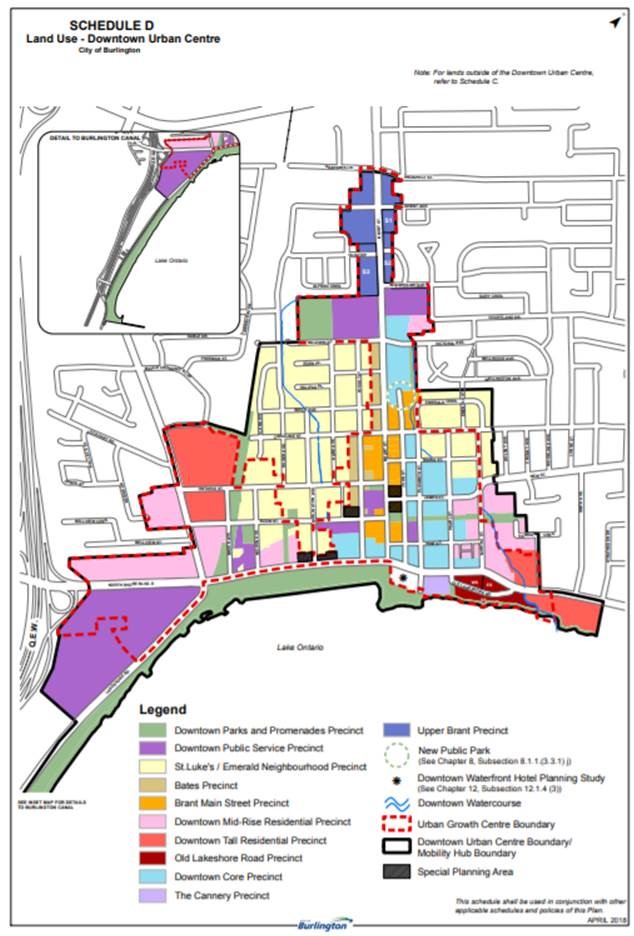
In 2016 there were 156 p&j (a combination of people and jobs) per hectare in the Urban Growth Centre.
The goal for our UGC is 200 p&j per hectare – thus in 2016 we had achieved 78% of the goal.
The 2031 target is 104.6 ha x 200 p&j for a total of 20,920 people and jobs in the Urban Growth Centre.
In order to meet the 2031 target the city needs to add 4,540 p&j in the next 12 years.
Is that possible? Scobie thinks so and he offers the following data to make his point
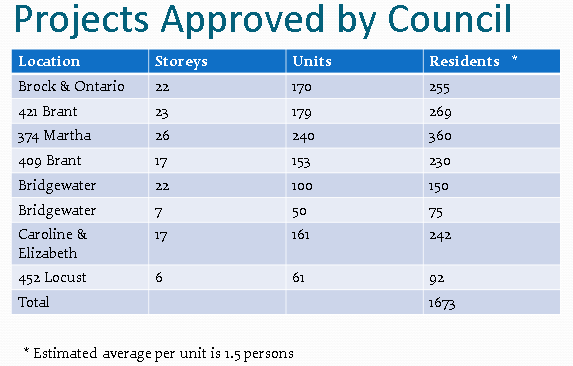
These developments will add 2824 p&j in the not too distant future which will make Burlington short 1626 of the target. Note that Scobie uses an estimate of 1.5 residents per housing unit.
There is more maintains Scobie and he points to projects that are “in the works”.
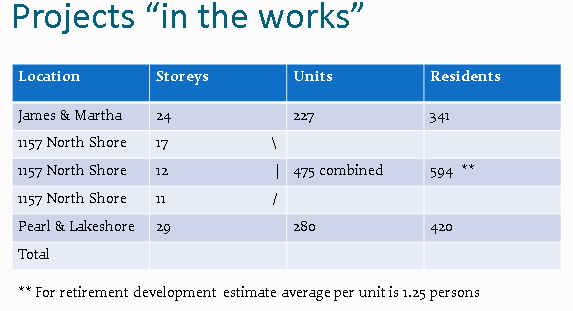
 A development planned for the corner of Pearl and Lakeshore is to be 29 storeys – a record high for the city. Scobie, who shares the view of Mayor Meed Ward, maintains the city does not need 20 storey towers to meet the Places to Grow population target.
He suggests that the projects in the works will add 1355 people and 180 jobs for a total of 1535 p&J and that permitting buildings that are between eight and 11 storeys will let the city reach the objective. No need for the 20 plus storey towers that will destroy the small town feel that residents want.
“We don’t need more 20+ storey buildings to reach the target. Mid-rise building can get the city to the point where it has met the growth requirement and allow a more human scale of development.”
Is Scobie right?
 Gary Scobie: Are his numbers right? Hard to tell – none of the Councillors who heard the Scobie delegation asked city staff if Scobie’s numbers were right.
The Gazette has fired off an information request to Mary Loy Tanner, the former Planning Director who oversaw much of the development that has residents upset enough to elect a significantly different council.
Our question to Tanner is:
On Tuesday, February 6th, Gary Scobie made a delegation to Council. A copy of the slides he presented is attached. Are the numbers Scobie presented correct?
If they are incorrect could you set out where his numbers are wrong.
Thank you 🙂
A question we have for the members of council who heard the delegation: Did the cat get your tongues or did you agree with Scobie? At the end of his delegation there wasn’t a single question asked. Not what they were elected to do or did we get that wrong?

 By Ray Rivers By Ray Rivers
February 6th, 2019
BURLINGTON, ON
“The most divisive and negative and nasty political campaign in Canada’s history”
That was Justin Trudeau’s prediction for the upcoming federal election as he addressed a Liberal fundraiser last October. And he only had to wait a couple of months to see his prophesy come true.
About a week ago federal Conservative leader Andrew Scheer posted an ad on his Facebook and Twitter accounts which can only be compared to the one PM, Kim Campbell, released on national TV during the 1993 federal election.
 Politicians do what they think they have to do to either win public office or retain the office they hold. Kim Campbell didn’t hold the office of Prime Minister for very long. Campbell’s ad asserted that Chretien would be an embarrassing PM for Canada because he had a facial birth deformity compromising how he appeared and spoke. Campbell, to her credit, apologized and cancelled the ad the following day.
She claimed she hadn’t actually seen the ad, having trusted her campaign team to save her harmless. That was a huge mis-judgement on her part and it helped cost her the election. In fact she presided over the biggest election loss in the history of the Progressive Conservative party – going down to two seats. But that didn’t stop the Tories from using nasty ads in their election campaigns.
Mr. Harper was a little subtler when he went after Liberal leader Stephane Dion, who suffered from what appeared to be panic attacks that spoiled his messaging in either official language. Harper’s ad focused on images of a man struggling for words and thereby depicting the otherwise polished and professional Dion as an inexperienced bumbler. And in this case it worked.
It should be no surprise then that Harper’s protege would follow his lead. But unlike Campbell who pleaded ignorance, Scheer’s hands are all over the recent attack ad. After all who but Scheer had posted them directly onto his personal social media pages.
 Politicians can sometimes be just a little too cute. Andrew Scheer at his cutest? Mimicking the popular Historica Canada produced ‘Heritage Minutes’ which appear regularly on CBC, his ad focused on Trudeau’s occasional stutter or shortness of breath. Whatever the cause, this is something we had all witnessed during the three leaders’ debates in the last federal election. Stutter or not, the voters who gave him a majority government would have to say Mr. Trudeau won those debates.
So what does it say about Scheer, the wannabe PM, that he doesn’t get it? It’s supposed to be about what you say and not how you say it. Canadian voters respect fair play. By all means attack Mr. Trudeau for what he stands for and what he has done, but don’t just expect voters to flock to you because you denigrate your opponent for a physical imperfection, or whatever a stutter is.
 The Conservative Party created this attack ad parody of a popular TV segment called Heritage Minutes. Historica Canada requested it be deleted, and it subsequently was. And talk about slow learning. After the non-partisan Historica Canada complained vigorously about this cheap stunt compromising their own integrity, Sheer took down the ad. Then he posted it almost immediately, minus any direct reference to the Heritage Minutes.
Then Scheer removed it again, finally concluding that it was inappropriate. Had the intent of this little caper been to showcase the competence of the new Tory leader, all it demonstrated was nastiness, poor judgement and indecisiveness.
Historica Canada is still waiting for a simple apology. And so is the Prime Minster as are the rest of us Canadians.
 Ray Rivers writes regularly on both federal and provincial politics, applying his more than 25 years as a federal bureaucrat to his thinking. Rivers was once a candidate for provincial office in Burlington. He was the founder of the Burlington citizen committee on sustainability at a time when climate warming was a hotly debated subject. Ray has a post graduate degree in economics that he earned at the University of Ottawa. Tweet @rayzrivers Ray Rivers writes regularly on both federal and provincial politics, applying his more than 25 years as a federal bureaucrat to his thinking. Rivers was once a candidate for provincial office in Burlington. He was the founder of the Burlington citizen committee on sustainability at a time when climate warming was a hotly debated subject. Ray has a post graduate degree in economics that he earned at the University of Ottawa. Tweet @rayzrivers
Background links:
Heritage Minutes – Chretien Ad – Dion Ad –

 By Jim Feilders By Jim Feilders
February 4th, 2019
BURLINGTON, ON
During a presentation at the Burlington Seniors Centre by Burlington Urban Forestry staff and Ward 4 Councilor Stolte said she would like to complete the pilot faster than the two year period.
The Urban Forestry manager indicated many benefits including what Toronto has recognized – shading. Changes since 2013 when Council did not support a private tree bylaw – the ice storm, flood, wind storm and Emerald Ash Borer resulted in Council changing their minds. Roseland was chosen for a number of reasons and data will be gathered for analysis.
A proposed Private Tree Bylaw Pilot was approved at the Committee of the Whole March 19, 2018. The proposed pilot will be a two-year project for the Roseland Area, starting March 2019, and finishing March 2021.
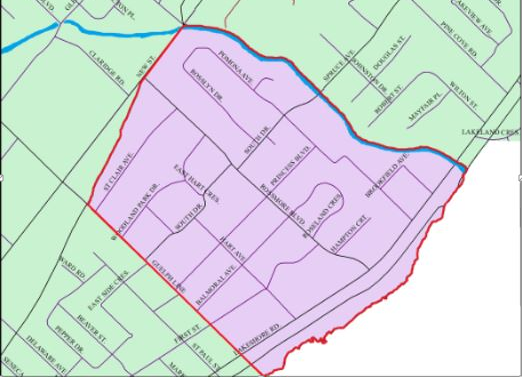
The Roseland area is bordered by Guelph Line to the west, New Street to the north, Roseland Creek to the east, and Lake Ontario to the south.
This exciting initiative is based on a recommendation from the city’s Urban Forest Management Plan that was developed in 2010.
This program will aid in preserving valuable urban forest assets in an effort to maintain and grow a healthy and vibrant community resource into the future.
The bylaw will allow for some flexibility for private property owners, yet includes restrictions based on preserving heritage and “significant” trees. Replacement plantings are important for ongoing sustainability of Burlington’s Urban Forest, and are proposed for trees greater than 30cm (1 foot) diameter at breast height (dbh).
The 30 cm exemption was based on a survey of other municipalities and felt it was a moderate approach.
Boundary trees are also addressed.
Exemptions will be allowed for specific instances including emergency work; trees posing high risk as deemed by a Certified Arborist; ash tree removals, or removals allowed under the Planning Act.
At the end of the two-year pilot period, a review of the Bylaw will be undertaken, with a report to Council, including the feasibility of further rollout city-wide, and resource implications. The bylaw will be enforced by The Manager of Urban Forestry and any designate, who will have the authority to:
• Issue Tree Permits
• Issue work orders directing as to how authorized work is to be conducted. The authority to issue work orders shall also include the authority to order a stoppage of work
Burlington’s Strategic Plan identifies expansion of the urban forest to be a key action item in our strategic direction of a Healthy and Greener city.
The bylaw requires applicants to submit an application to the Manager of Urban Forestry or their designate with the following information:
• A Tree Protection Plan acceptable to the Manager of Urban Forestry or designate, identifying the trees to be injured or destroyed, and including size, species, condition and location; the trees to be kept; and measures to be taken for the preservation of remaining trees on the site
• The permit fee
• A proposed for tree replacement planting plan
• Confirmation that tree protection fencing around city trees is done so in accordance with the city’s Standard Specification for Tree Protection and Preservation (SS-12A)
• A schedule of proposed site inspections to be completed by the project arborist
• Project scope including but not limited to an explanation of proposed demolition (if applicable), construction, equipment used, timing, detailed explanations of any applicable work within tree preservation zones
• Boundary trees located within three metres on both sides of a mutual lot line require a letter of agreement signed by the adjacent neighbor(s); or documentation from the Project Arborist that the proposed work will not negatively impact the tree in question
• Any additional relevant information
Applications and all necessary paperwork can be submitted to Roads, Parks and Forestry at 3330 Harvester Rd. Burlington, Ontario or by email at forestrypermits@burlington.ca.
1. Applications will be reviewed by Forestry staff and the applicant will be notified of any missing items. Forestry staff will respond to the applicant within five business days.
2. If the application is complete, a site meeting will be scheduled to discuss acceptance or denial of application, further modifications needed, and subsequent securities and/or compensation costs to be incurred by the applicant.
3. Upon approval of the application, the applicant is required to provide payment to the City of Burlington for the required security and compensation amount per the bylaw and indicated in the approved arborist report and preservation plan.
4. A Tree Permit will be provided to the applicant which must be displayed on the property in view from the road.
$100 per tree to be removed or injured up to a maximum of $500.
There is no cost for ash tree removal; however, replacement trees are still required.
When a tree permit has been granted, all owners are required to replace trees that are proposed to be removed, or pay cash-in-lieu of replacement of $700 per replacement tree:
Diameter Class (Removed Tree) No. of Replacement Trees Required

The manager said the real results of such a bylaw are the withdrawal of applications. People rethink the removal of trees.
This could skew the statistics to be analyzed as there will be fewer trees removed and less statistically significant data)
Q&A
Q1. How was replacement size determined?
Ans. Picked the middle of the road from other municipalities as a good starting point.
Q2. Why no fir trees protected?
Ans. Not a Carolinian tree so no need to protect.
Q3. How soon will City respond?
Ans. Within 5 days initially.
Q4. Kudos for bylaw. What is age of 30 cm tree?
Ans About 30 to 50 years
Q5. Could we go lower like Oakville?
Ans Yes they have 15 cm
Q6. Where is money to take care of City trees?
Ans Using a 7 year rotation throughout the city so every area gets pruning once every 7 years. Now that risk assessment is done should be able to do better.
Q7. Very costly to haul excavated basement fill off site in order to protect trees. Can’t protect all trees as some are in the way of a house. Can trees in building envelope be removed?
Ans Can remove trees in the way but have to apply. Provincial policy trumps municipal. Province says housing has preference.
Q8. Why is there no tree canopy target?
Ans We don’t know how many trees we have. UFMP needs an update to see what have been lost since 2010. Some municipalities have lofty goals that they might not meet.
Q9. We had 17% canopy in 2010 and has been decreasing since. Conservation Halton gives us a failing grade and Environment Canada says 30 to 50%. We are not progressive enough. What is replacement plan?
Ans For each tree of 30 to 50 cm diameter have to plant 2 at 5 cm for $1400. (Editor’s note – the Site plan Application Guidelines, Section 9 for development applications require equivalent caliper replacement. For a 30 cm tree this would require 6 trees at 5 cm, not 2 trees).
Identified vacant tree sites in Roseland have been identified for new plantings.
Q10. Need help from residents in Roseland. History is that we asked for what we thought the current council would accept but need a better city wide bylaw. Lost 80 city trees recently and over 100 other trees. Canopy is not looking good. In the Character Study, trees were identified as the most important aspect of Roseland. The new OP mentions importance of character throughout. We need a proper renewal plan.
Q11. We have only 12 years to counteract climate change and we must save every mature tree. The new Council is progressive while the Province is regressive. Trees help flood prevention and carbon sequestering. We need to move faster and ask for 1 year to go for a city wide private tree bylaw. We can’t take the soft sell approach any longer. We should take a stand and chose a 35% tree canopy target. Burlington has lagged behind others. There are programs available to help with costs. We have to ramp this up.
Ans Echo that and every tree matters.
Q12. Can we have an interim review?
Ans We are following Council direction but may be able to have a one year review
Shawna – We need to convince council, not staff. 3 councillors want a smaller tree diameter limit for north Burlington as most trees are smaller than that.
Urban Forestry manager – contacting businesses involved about awareness so they are not caught unaware.
Q13. Need incentives to plant new trees.
Ans Looking at other aspects as well as preserving mature trees.
Q14. Heard of new developments planting trees on private front yards instead of city land then cutting them down. Allowed in Burlington?
Ans No. Above Dundas, trees are going on city property.
Q15. Staff should let consultants, architects and planners know about the bylaw a soon as possible.
Q16. Committee of Adjustment is not considering tree policies that exist now.
My own take on this:
Any tree can be destroyed provided it is either exempt, compensated by cash in lieu or agreed by neighbour. This bylaw will not prevent the loss of mature trees occurring at present.
The replacement option is not based on equivalent caliper diameter as is required in the Site Plan Application Guidelines for development applications. A 30 cm diameter tree would have to be replaced by six 5 cm diameter trees, not two. A 50 cm diameter tree would have to be replaced by ten 5 cm diameter trees, not three.
Trees on private property removed for personal improvements (pools, decks, additions) and infill development do not represent a large number of trees. Over the next ten years this will account for about 14% of all removals in urban Burlington. The real problem is sick and dying trees.
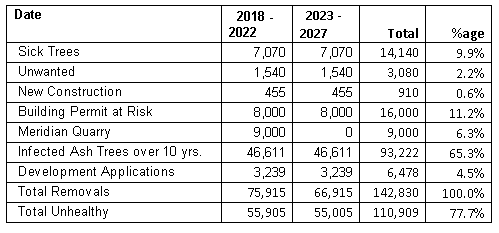
The evaluation criteria for the analysis was not given. The report from staff stated there would not be sufficient data to draw meaningful conclusions and no other municipality has proven the effectiveness of a tree bylaw.
“ It does not recommend a pilot project, primarily because of the difficulty of assessing the effectiveness of a pilot project, but does set out the key parameters of a pilot project should Council wish to undertake a two year pilot.‘
“While some municipalities have private tree bylaws, they are generally municipality-wide. Staff have found little evidence that private tree bylaws have been subject to rigorous assessment of their effectiveness, and in many cases the stated goals of municipal private tree bylaws are more subjective and philosophical than objective and measurable. There is a general belief that the municipality has an obligation to put processes in place to regulate the removal of private trees by putting in place a process that ensures the owners seriously consider the decision to remove a tree, educates the owners, and ensures the replacement of private trees that are removed.
“While these may be very legitimate goals, there is little evidence found that shows that these bylaws ultimately have had a measurable impact on the quantity or quality of the urban forest, or are more effective than other strategies to retain and enhance the urban forest.”
“Therefore, it is estimated that approximately 1.7 million trees exist within the city’s urban area. Other than this estimate, we have no baseline by which to measure, track or evaluate the success of a private tree bylaw pilot project on the tree canopy. It is also suggested that the scale of the tree canopy alone may not be the best by which to measure urban tree forests. Other cities include such measures as diversity of species, physical access to nature, habitat provision, tree health and characteristics of the trees (size).
 It was private property – not in Roseland. Evaluating the effectiveness of a pilot project would be further complicated by the time-limited nature of the pilot in a relatively small area of the city. In short, the city would have little or no baseline on which to measure change, and enforcement of the bylaw would be either voluntary, or by complaint. The city does not have the resources to actively police tree removal in Roseland. In the case of a time-limited trial, people could either remove trees in advance of the pilot starting, or wait it out. In summary, it is not clear that there would be any viable means to measure the effectiveness of a private tree bylaw trial project.
Sample size would also be an evaluation challenge. Staff estimate that in a two-year trial period in Roseland there may be 40-50 permits granted, although given the city’s lack of experience in the area, this is at best a rough projection. If the estimate is accurate however, it would be very challenging to extrapolate the impact of the pilot from such a small sample size on the overall urban forest of 1.7 million trees.
Moreover, except for the existence of some degree of community support, there is no other reason to undertake a pilot in Roseland, rather than other parts of the city that also have mature private property trees.
Further community consultation undertaken in Roseland since the staff direction to consider a pilot, shows that the community is highly polarized on the issue. People are either passionately in favour of a bylaw, or strongly opposed on the basis of private property rights. Few, if any people, were indifferent.
 Scenes like this all over the city. Value to Community
Even if it can be determined that a private tree bylaw is bringing value to the urban forest, it is possible that the same resources committed to education and/or actively expanding the forest on city property, might have a greater impact on protecting and enhancing the urban forest as a whole. Again, given the lack of research on the effectiveness of private tree bylaws, there is little way to assess this.”
The Urban Forestry Manager stated the best result of a bylaw is that potential applications are withdrawn or not submitted in the first place which indirectly results in preservation of mature trees. Thus the conclusion of the analysis will most likely be that not enough trees were destroyed to devote staff resources to implement the bylaw and that private citizens were unduly charged money for a problem that did not exist.
 The solution to the size of the tree canopy problem is planting more and more trees. The best solution appears to be planting new trees. The proposed bylaw is deficient in this regard. The conventional approach used by others is equivalent caliper diameter although some cites use a metric related to canopy size by a certain time frame. Using two or three small replacement trees for those removed that are not exempt will provide very few new ones.
Of the 14% or so of trees being cut down that fall under the bylaw, about 31% are 30 cm diameter or under (exempt), 37% are between 30 and 50 cm and 32% over 50 cm in the areas south of the QEW.
This means that 2 tree replacements would occur for 37% and three replacements for 32%. Continuing with the math shows 2 trees for .14 x .37 = 5% and 3 trees for .14 x .32 = 4.5%. So, the new replacements would be 10% and 13.5%, respectively for the two tree diameter groups or 23.5% in total. In other words, for every 100 trees cut down, 24 would be planted.
This will not increase the urban tree canopy. The bylaw should use a smaller diameter exclusion and equivalent diameter replacement. 86% of trees are over 15 cm with an average diameter of 57 cm. This would mean 11 replacement trees for each one removed. The math then becomes .14 x .86 x 11 = 132%. Now we’re getting somewhere. More new trees than those destroyed. But this will not grow the urban canopy by much. We need twice as many trees than currently exist. We probably have about 1.5 million trees now and will need 3 million to get to a 30% urban canopy.
In addition, the City could offer free trees to homeowners.
If every household in urban Burlington planted a tree it would be about 75,000 trees and put a dent in the 111,000 to come down over the next 10 years.
Conclusion
The pilot bylaw will not reduce the number of healthy mature trees being destroyed and will not provide enough replacement trees to offset those being destroyed.
 This is what most people in Burlington want; a gorgeous urban tree canopy that shades our streets, improves property values and gets some of the pollutants out of the air. But at the same time people want to be able to cut down a tree on their propeerty if they don’t like them. We can’t have it both ways – can we? 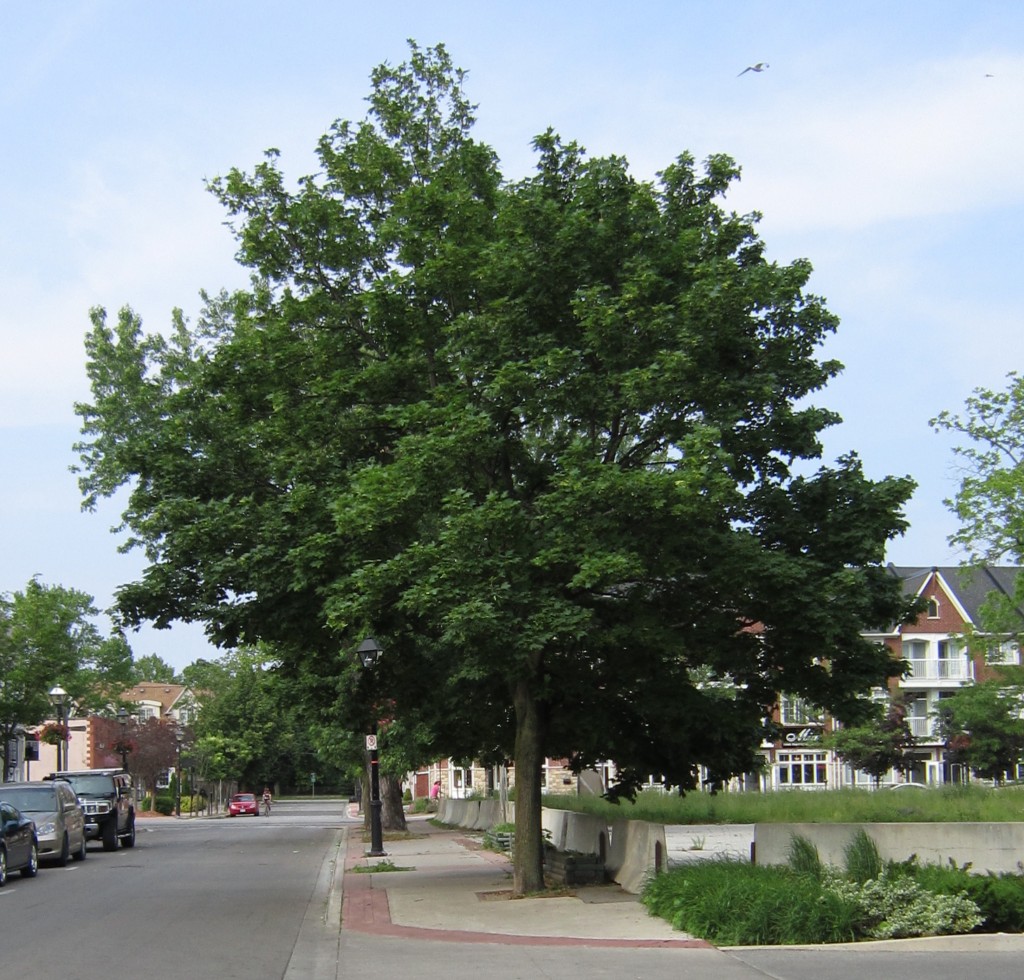 It was a beautiful tree, magnificent, resplendent – but it was cut down allow for the construction of a retirement home. The analysis in two years will conclude there is no justification for a private tree bylaw city wide.
Council needs to revise the pilot program immediately.
Jim Feilders has been a strong environmental advoate for decades and thinks the city has got the pilot private tree wrong,

 By Pepper Parr By Pepper Parr
February 4th, 2019
BURLINGTON, ON
The Mayor’s State of the city address last week before the Chamber of Commerce was a first for Marianne Meed Ward. She will get to do this three more times before she has to go before the electorate who will decide if she has heard what the city wants and has made measurable strides in getting there.
She spoke at length last Wednesday, she did not get a standing ovation and there were a few issues – climate change and the private tree bylaw – that got a clap or two from a tree hugger or a “this is a hill to die on “ environmentalist.
She was a little off her pace on a very few occasions – but at the end of the session when people were getting their coats and preparing to step out into some very cold weather there were a number, a rather significant number of people who were lined up to say a few words to the new Mayor and hang around to have pictures taken.
The Gazette has published State of the City address for the past eight years they aren’t the kind of thing that people dig out of the archives. We publish them for the record.
The Meed Ward address had a lot of information that has to be teased out and looked at in a larger context. The Gazette will be doing a series of articles in the next few weeks drilling down into what she had to say and suggesting as well as we can what we might expect from our Mayor.
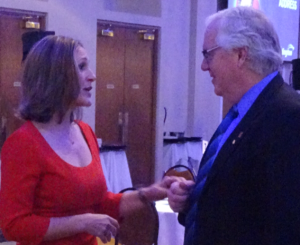 Mayor Meed Ward chatting with one of the people who attended her State of the City address.We have been watching Meed Ward for more than ten years; we sat in on several of her early campaign meetings when she first ran for the ward 2 seat in 2010.The issue that will overshadow all the others is the Region’s decision to return the Official Plan. Here is what Meed Ward had to say on that: “As a result, I am bringing forward a motion to re-examine the policies of the Official Plan that was adopted, though not officially approved, in April of 2018, and review matters of height and density. Halton Region has also recently identified areas of non-conformity, so this motion seeks to gain the time to address those issues.
“Once the Region identified areas of non-conformity, that stopped the clock on approving the new Official Plan and opened the plan up for any other matters of discussion. This allows our new City Council the time to define what areas we want to study, undertake that work, consult with the community, and send back a comprehensive plan. We expect that plan to truly reflect the needs, best interests and vision of the community and its elected Council.
“The motion will also provide absolute clarity to staff and to the community that the City of Burlington staff are not to use the adopted 2018 plan in evaluating current/new development applications and the existing Official Plan is still in full legal force and effect. Multiple analyses by staff in assessing development applications, downtown in particular, have made it clear we do not need to over-intensify in order to meet our obligations under the Province’s Places To Grow legislation.
“Further, we will immediately discontinue use of the “Grow Bold” term and related branding to ensure we are absolutely clear on our direction.”
There are some critically important phrases:
this motion seeks to gain the time to address those issues.
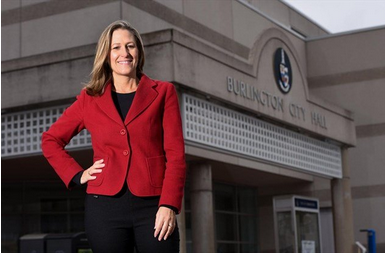 She is focused on putting her mark on city hall. stopped the clock on approving the new Official Plan and opened the plan up for any other matters of discussion.
The motion will also provide absolute clarity to staff and to the community that the City of Burlington staff are not to use the adopted 2018 plan in evaluating current/new development applications and the existing Official Plan is still in full legal force and effect.
Meed Ward knows exactly where she wants to go and has a council with five new members that has yet to find its footing – they will follow her lead – it is what they based their individual election platforms on.
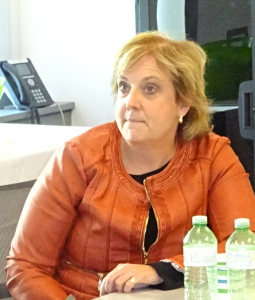 Deputy city manager Mary Lou Tanner. The really strong differences of opinion between the Mayor and the Deputy city manager are so wide and have been that way for a long time – one of them has to go – not much guesswork on who will be clearing out a desk before the end of the year.
The Planning department is going to have to come into line very soon with the thinking that is taking place at council.
Roman Martiuk, failed to advise council that there was going to be a $9 million budget surplus in 2011 – that cost him his job.
Martiuk used to tell council he was there to “serve the will of council”. Interim city manager Tim Commisso is going to have to determine just what the will of council is and then ensure that the departments fall into line.
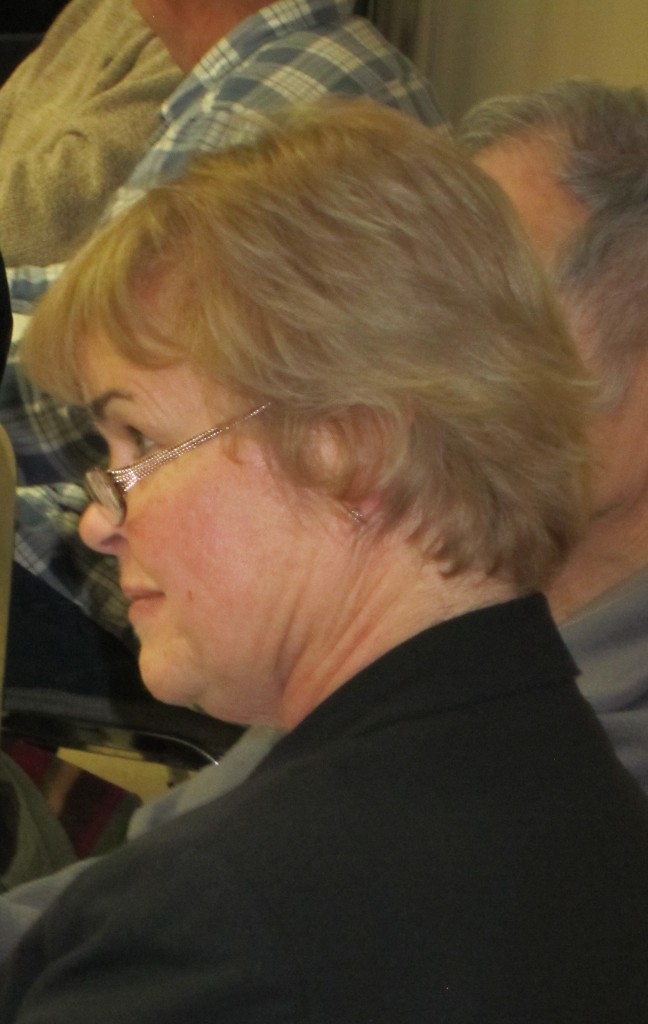 Director of Finance Joan Ford There are several departments that have been doing a fine job for some time: Finance, Capital Works and Information Technology are worthy of bonuses. Planning is a mess; Transportation is so far behind in several of its critical reports that are holding up a number of other initiatives.
The world of municipal administration has to be in tune with the political changes that take place in a community. There are some at city hall who appear to have tin ears and don’t understand the change that took place last October when the ballots were cast or they don’t care and will continue to do what they have been doing since those ballots were marked.
Meed Ward has made it abundantly clear – the times have changed – get with the plan.
There are some very smart and dedicated people in the Planning department. For about a dozen their career paths have been inhibited by the organizational mess and the leadership failure within the department; the place isn’t the planning mecca it could be.
 Let’s look at this again in a year and see if there have been any real changes. Let’s look at this again in a year and see if there have been any real changes.
Right about now one can ask: Where is the Work Force Plan that Tim Commisso will have to put before city council at some point in the near future. What we learn tends to come out of the Mayor’s office.
Salt with Pepper are the views, opinions and reflections of the Gazette Publisher

 By Jim Young By Jim Young
January 31st, 2019
BURLINGTON, ON
On Tuesday night last week, I attended the Public Information Session for the Carriage Gate Development at 2069-2079 Lakeshore Rd. and 383-385 Pearl St.
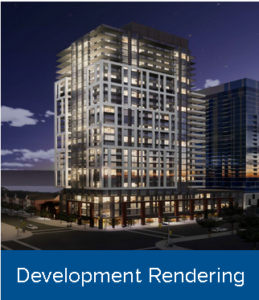 Proposed 29 storey development will be kitty corner to the 22 storey Bridgewater development now under construction. The proposed building is at Pearl and Lakeshore sharing the block with the ADI 26 storey building that was imposed on the city by the old OMB. Carriage Gate are seeking amendments to the Official Plan and zoning bylaws to allow 29 storeys in an area zoned for 4 (8 with permissions) It will have 280 residential units and 675 square metres of commercial space.
It will only have 280 parking spaces for residents and 11 visitor/retail parking spaces. Existing zoning requires 500. Setbacks are reduced from 2 meters to zero.
The developer suggested that the 26 storey building approved next door and others on Brant St. serve as a precedent. It was pointed out from the floor that the 26 storeys was imposed by the OMB and never actually approved.
It was obvious from the presentation, and introduction by City planning Staff, that the Official Plan rejected by the region and under review by city council, is still being referred to by both the developer and city planning staff.
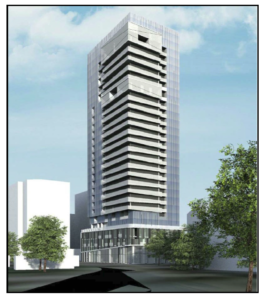 The Nautique, in the same block as the proposed Carriage Gate development has the approvals it needs. Testing to determine where the water table is being done – five levels of parking are proposed. Citizens voiced concerns about the traffic this development will bring, particularly during rush hours, the lack of parking provided for owners and retail customers and the need to back trucks up to the service entrance on Pearl Street. Assurances that lakeshore would not be narrowed during construction were not forthcoming. Many of the city planning and developers comments were met with laughter or anger.
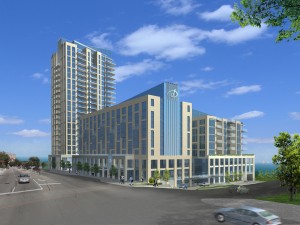 Described as a “legacy” development when it was proposed back in 1985 – the Bridgewater will become the best hotel the city has – until the Waterfront Hotel gets redeveloped. Asked if they really think about the impact on people or how disrespectful of citizens and council their proposal to build a 29-storey building in a 4 storey zone is, the developer’s representatives declined to reply. This brought derisive applause from those present. When one attendee asked for a show of hands from the audience there was not one hand raised in favour.
After the meeting I got an email from another concerned citizen. He fears that the height precedent was already established by the OMB decision on the adjacent ADI development no matter which OP is used. He wondered if the bedroom sizes, parking space allocation and minimum tall building footprint sizes would meet approval standards in Toronto or even Hong Kong. He was only half joking. He voiced concern about the huge gulf in understanding of what the process is and how best the public can present counter proposals.
That’s where the public expect their mayor and councilors to step up. People have a hard time understanding why city planners work hand in hand with developers to implement an amendment for 29 storeys that is so far higher than the Official Plan “In force and effect” which allows only 4, and why they still consider a plan reviled by citizens, rejected by the region and under review by council for significant changes.
Members of the public fear that city planners are being strung along; debating an amendment that should be rejected out of hand, eating up city planning time and expense while running out the clock on the 210 days the city has to respond to developers. When that time runs out the developers simply appeal to LPAT leaving the city in a position they cannot defend and looking foolish when the LPAT rules in the developers favour.
 Councilor Kearns seemed skeptical, but reserved comment until she has time to consider the whole proposal. The Councilor has known about the proposal for more than a month. Mayor Meed Ward, Ward Councilor Kearns, Councilors Nisan and Bentivegna attended the meeting. Councilor Kearns seemed skeptical, but reserved comment until she has time to consider the whole proposal, Mayor Meed Ward advised the audience, the developers and, indirectly, city planners; that a motion is coming to direct planning staff to only consider the “in effect” official plan and not the regionally rejected one.
Following similar outrage at the Public Meeting on the Proposed Development at 1157-1171 North Shore Blvd and a Councillors Workshop on The Planning Process, I reached out to Councillor Galbraith, Deputy City Manager Mary Lou Tanner and Planning Director Heather MacDonald to ask that a similar workshop on the process be held for interested citizens to help avoid this conflict. I received positive responses from Councilor Galbraith and Ms. Tanner. I am still waiting for Ms. MacDonald. Must I wait 210 days then appeal to LPAT?
Jim Young is an Aldershot resident who delegates frequently at city hall. He is a member of a city Advisory Committee.

 Ray Rivers Ray Rivers
January 31st, 2019
BURLINGTON, ON
What was John McCallum thinking when he blurted out his innermost thoughts on the extradition of Huawei executive Meng Wanzhou, currently on bail and awaiting trial. It is inappropriate for any public official, including a diplomat, to wade in on a matter before the courts. And McCallum, an experienced former government minister, would have had that drilled into him.
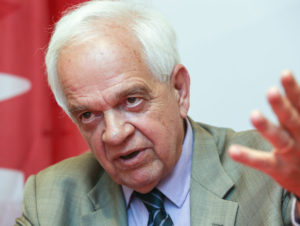 John McCallum, was the Ambassador to China and was once a senior officer with the Bank of Montreal. He is now retired. He told an audience of Chinese-Canadian media that Ms Meng had a strong legal case and implied she might likely be acquitted. While most observers would have agreed with the reasonableness of that statement, most observers feigned outrage that he had said it publicly. And it took less than a heartbeat for opposition leader Andrew Scheer to demanded his resignation.
McCallum did eventually apologize for ‘mis-speaking’. But I guess he didn’t really mean it because he immediately unloaded a second bombshell – that it would be good if the US just dropped the extradition. And that was the proverbial straw on Mr, Trudeau’s back which did get him fired.
McCallum’s wife is ethnically Chinese and he apparently had wanted this posting, giving up his Cabinet job happily in exchange. Perhaps he was tired and did just mis-speak? Perhaps he was trying to ingratiate himself with his Chinese ethnic audience? Perhaps he thought it was fair game to chirp in on the Meng case given his role as Canada’s representative to China? And perhaps he was trying to move the diplomatic goal posts a little?
After all Canada and China are at an impasse on this messy Meng affair. A nation of laws, the PM says, we were simply complying with an extradition treaty obligation, and we will not be moved. Meanwhile China has nabbed a couple of Canadians and given a death sentence to another, just to show they really mean business. To China it’s all about politics and its all negotiable.
Perhaps McCallum realized that. In order to stop this rash of hostage taking by Chinese authorities something had to be done. So give them hope, or at least false hope. And it may have worked since the hostage-taking seems to have abated. And who knows that he didn’t secretly develop this strategy in cahoots with the PM’s office in the first place?
 Meng Wanzhou; Chief Financial Officer with a prominent Chinese corporation that is a leader in the telecommunications field is on bail awaiting an extradition hearing to the United States. The Canada-China dynamic has changed now that the US has actually filed its extradition papers. Washington, and not Ottawa, is the object of China’s angst now, regardless whether Ms Meng is extradited of not. And her future, assuming she is extradited, will be in the hands of the Chinese and American trade negotiators as they conduct the most important trade negotiations in their history.
China was once the world’s largest economic power. Back in the 1800’s the Chinese economy generated almost a third of global GDP and it is on track to overtake America sometime in the next decade.
Ms Meng’s Huawei is the second most popular mobile systems provider in the world, recently beating out Apple and just trailing Samsung. And while it claims to be a private entity, the Meng escapade shows how it’s not. Despite all protestations China is nothing less than a modern national-socialist state, with Huawei its monolithic telecommunications showpiece.
Huawei is a restricted telecom in three of the ‘five-eyes’ nations, US, Australia and New Zealand. That is because they are convinced the company represents a security threat – read espionage. The UK and Canada have been on the fence, but after China’s recent behaviour towards Canada, does anyone really think, we’ll let them help us develop our 5G systems.
It may be arguable that the Trump administration purposefully boxed us into this predicament regarding Ms Meng, but it sure looks like it. Clearly the US would like us to reject Huawei for any number of obvious reasons. So if the Yanks set us up for this conflict with China, the Chinese have played into their hands, and the Americans will likely score.
Mr Trudeau had hopes when he came into office that a free-trade deal with China would take pressure off NAFTA negotiations. But it became clear to Mr. Trudeau, after his 2017 visit there, that the ideological gulf between us is just too wide. Today’s China as not a suitable long term trading partner. There will be no free trade agreement between our two nations and Huawei will have lost Canada.
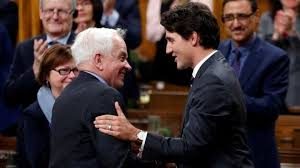 Best friends forever – until you say the wrong thing: John McCallum with Justin Trudeau in the House of Commons. Trudeau fired McCallum because he had to. You can’t have a diplomat who appears to have eaten strange mushrooms and gone rogue while on duty. But the firing itself was another message for the China authorities who apparently liked our man in Beijing. It shows a certain toughness on our part. We may still be a small country but we’re not going to be pushed around.
The Chinese still revere Justin’s father for breaking international trade sanctions back when Mao was being shunned by the west. But if Pierre helped open the door for them then, it looks like it’ll be his son’s job to close it, at least as far as Huawei is concerned.
John McCallum may have knocked over the diplomatic applecart by his actions – but it would be hard to make a case that he did any significant damage to Canada. And we’ll never know why he did what he did. Was he a sacrificial lamb helping to throw the Chinese leadership off their game? Or was he just another useful idiot?
 Ray Rivers writes regularly on both federal and provincial politics, applying his more than 25 years as a federal bureaucrat to his thinking. Rivers was once a candidate for provincial office in Burlington. He was the founder of the Burlington citizen committee on sustainability at a time when climate warming was a hotly debated subject. Ray has a post graduate degree in economics that he earned at the University of Ottawa. Tweet @rayzrivers Ray Rivers writes regularly on both federal and provincial politics, applying his more than 25 years as a federal bureaucrat to his thinking. Rivers was once a candidate for provincial office in Burlington. He was the founder of the Burlington citizen committee on sustainability at a time when climate warming was a hotly debated subject. Ray has a post graduate degree in economics that he earned at the University of Ottawa. Tweet @rayzrivers
Background links:
McCallum Tweets – McCallum Firing – More McCallum –
Scheer on McCallum – US Extradition Charges –

 By Staff By Staff
January 30th, 2019
BURLINGTON, ON
The Burlington Gazette has published the State of the City Address verbatim for the past nine years.
The full address given by Mayor Marianne Meed Ward is set out below.
8:00 am, Wednesday January 30th, 2019
Burlington Convention Centre
John Goodwin, Chair of the Board of the Burlington Chamber of Commerce, welcomed a sell-out crowd of 500 attendees, thanked notable guests including two local MPPs and the Mayor of Oakville, thanked sponsors, and introduced Antoine Shiu from Cogeco to introduce Mayor Meed Ward.
Antoine Shiu then spoke, referencing the Mayor’s experience and service as a civic leader, her passion for listening to constituents, and keeping the people of Burlington informed about what’s going on at City Hall. “I’d like to invite our mayor up to the stage to tell you more about city council’s vision for our city and the plans they have for making it all happen.”
Mayor’s Remarks:
Well good morning everybody, how is everyone this morning? I think introductions are a little like cooking. You know the saying that it always tastes better when somebody else cooks for you, and I love to cook but even I feel that way sometimes. Introductions are always better when someone else gives it to you so thank you so much, I appreciate that, they always sound better that way.
I really do want to thank all of you for being here and making this a sell-out event. This is absolutely incredible, and it really shows how interested you are – not just in me – but in our city and what happens to it and in ensuring a good future for our city. So I want to take a moment to just thank all of you for braving the weather – we’re Canadians though right – and coming out and spending about 3 hours with me while I give…no just kidding…about a half hour I think is what they gave me which is a true gift for me, I get five minutes at council, so I’m going to take advantage of every minute.
I do feel very lucky to be standing here before you as your Mayor. I pinch myself every morning when I wake up that it’s really true. And I know it’s true because of the butterflies in my stomach. So let’s carry on.
It is truly an honour to be here, and it’s one I take very seriously, but it’s also one that puts a smile on my face every morning, so thank you for that privilege.
I do want to acknowledge a few people here today, and you heard some of the sponsors, so I won’t go through them again, but I do want to thank all of the sponsors for making today happen. We couldn’t do it without you. I’d especially like to thank the Chamber for hosting, and also for what you do in the community all the rest of the year to promote business and retain business and make sure there’s a networking opportunity for all of us here. Thank you to Keith our retiring head of the Chamber, you leave very big shoes, and I think if we’ve learned anything it’s that your diet of only meat has gotten you a long way. And a special thanks to John Goodwin as well for MC’ing and for everything that you’ve done over the year during your tenure.
I also want to do a special thanks to Bell because of today being Let’s Talk. It’s so important for us to continue the conversation around mental health. Every single one of us knows somebody who has been affected by mental health issues, whether that’s a family member, a friend, a spouse, an employee, it’s so important for us to make it safe for us to talk about those challenges just as we would talk about our physical health. So make sure you tweet and do the hashtag, there is money that’s being raised, and this is not just an Ontario or a Canadian movement now, this is a global movement, and they’re targeting to raise $100M for mental health so I think that deserves a round of applause too.
I will be introducing my council colleagues shortly, but I have something special in mind for them (they know what it is). And it’s great to see the other elected officials here. Thank you for spending some time, I know how busy you are as well.
I want to thank our city manager (interim city manager) Tim Commisso, who is here. Thank you for being here. We have a lot of city staff joining us today and I do want to thank each and every one of you for being here. There are 1580 city staff in the City of Burlington and we know on council, and I certainly know, I couldn’t serve the community without the help of front line city staff, so I do want to thank all of you for what you do every day, and also for being here and taking an interest.
We have a number of agencies, boards, committees that are represented here today. I want to thank you for all of the great work that you do in our community. Again, we couldn’t do what we do in Burlington and serve our people without your help.
I also want to thank our media sponsor, in the back, thank you for broadcasting this to the folks who couldn’t join us today. This will also be on Facebook Live, right now, so folks can join in. we will have that posted online for anyone who couldn’t come this morning, and my remarks will be on my website later today as well. So just make sure you get my good side.
Finally I want to thank my husband, Pete Ward, who is here, and I won’t point him out ‘cause he likes it better that way, but I am so grateful for his support. We celebrated 25 years of marriage the day after the election, so I told folks… I spent over a quarter of my life with this wonderful man, and three children a daughter who’s 20 and boy and girl twins who are 18. I wouldn’t be standing on this stage without his support. He believed in me before I believed in myself, and that’s special. So thank you.
And finally, I want to thank the people and the business in Burlington that make our city great. The strongest part of our city is you, all of the people here, all of the people out there, that live here, that work here, that invest in our community to make it the wonderful place that it is, so thank you so much for everything you do, all year, and for many years.
So, I have three things that I’d like to share with you today. I do want to take some time to introduce you to our new council. I want to talk about the priorities; the things that we heard during the election from our citizens, and I want to talk about the vision that we have as a council and that I have as your Mayor, for the next four years but to set the future for Burlington in a way that reflects the citizen vision for our community.
I also want to share a few things about what we’ve accomplished so far. We’ve been on the job…I think about two months. We’ve done a lot, already, so we’ll talk about some of those things.
And as I talk, you’re going to hear about 3 broad themes:
Partnerships, change and openness.
So, let’s get started.
First, I want to talk about partnerships, and this will be not only a theme of my remarks today but a theme of my term for the next four years. Essentially it means that none of us does anything alone. Whenever we achieve great things it’s because we have partnerships with people coming alongside us working together for the same good. You know you’ve probably heard the saying that it takes a village to raise a child. I’d like to adapt that a little bit to our city and say that it takes a village to build a great community. Every voice matters.
I want to start by introducing you to the other folks around the table in council who will help me, and help us, achieve our vision for the future, and that’s your council colleagues. So as I call their names I’m just going to ask them to stand, and stay standing, until everyone is recognized…and I think everyone is here today.
So, in Ward 1 we have our newly elected councillor Kelvin Galbraith
In Ward 2, our newly elected councillor Lisa Kearns
In Ward 3, our newly elected councillor Rory Nisan
In Ward 4, newly elected councillor Shawna Stolte
In Ward 5, our veteran returning councillor Paul Sharman, now serving his third consecutive term
In Ward 6, our newly elected councillor Angelo Bentivegna
This is your new team.
I want to say a couple of words about our council, because this is one of the most diverse councils the city has ever had. First of all we have the most women on council the city has ever seen. 3 of us. 3 out of 7. And the first female mayor in 40 years. That’s a whole generation. And I mention that because recently I was at a high school – I do a lot of speaking at public schools and high schools – and a young woman came up to me after I spoke and she said “I’m going to be the next Prime Minister” and I said “Yes you are, yes you are, dream big!” and the importance – it’s so important for people to see themselves reflected in their decision makers and that’s what that does for those young men and women when they see a diverse council that looks like them.
And our council is starting to look like and reflect the people in our community. So just a little ‘fun facts’ about our council, and maybe after if you have some time to network you can try to figure out which one is which when I tell you some of these things.
• The average age has gone down by about 15 years; I used to be the youngest on council but there are now 4 younger than me
• We have two folks who are grandparents, we have two with high school or university aged children, we have two with kids in public school, including one with a brand-new baby, and one young’un who is still living the fine life with his girlfriend and no kids! I’ll let you figure out who that is too.
• We have three who are immigrants to this country, who were born outside of Canada.
That’s diversity. And you want to see not only diversity in our opinions reflected in council but you want to see diversity reflected in council itself. And I think we’ve done that. We’ll you’ve done that, in the last election you asked for change, you got it. So thank you.
Before I go any further, I do want to let them talk to you a little bit about their priorities for the next four years because we do this as a team and as a partnership. And there’s a little fun in there for your too so…roll the video.
VIDEO PLAYS.
Aren’t they awesome!? That’s the first time I’ve seen this actually. We had a great time, my staff and I, and the staff at the City, putting that together and we had just as much fun I think coming up with those last questions and I can assure you, we’re not drinking Kopi coffee this morning, so you don’t have to worry about that. But I would like to point out that on your table is a brochure that has all the contact information of every member of council and a little bit of bio about them, so I would encourage everybody to take one home…we want you to stay in touch…and as you can see we’re a fun group. We have a lot of fun while we are also doing the very important work of looking after the city on your behalf.
So let’s talk about our priorities for the next four years, and what we’ve done together already.
And a great sense of humour, which as you can imagine is pretty helpful to have when you’re doing
And the first theme that I want to talk about is change. On October 22nd, you, the people of Burlington, voted for change. 5 brand new council members, a new mayor, and one returning. You wanted to see, and you want to see, your vision for our city reflected in the decisions that we make on your behalf.
So what does that look like?
I’d like to talk about our top priorities, and the great thing is that if you look at the platform of all of brochures of the folks that did get elected, and I have, it’s very similar. There’s a lot of alignment. So that is great, it allows us to hit the ground running.
Previous council had adopted a 25-year strategic plan, we know that we need a 4-year action plan to start taking steps in that direction. So, right away, as soon as we were elected, this group got together in December, with our staff, and started talking about ‘what’s our work plan for the next four years’? They’re very keen, by the way, this group. They don’t waste any time.
So we hope to have something to show you in March about what our action items for the next four years are going to be to start moving in the direction of our vision for the city.
I want to talk about some highlights, of those things.
The first thing we’re going to do, is we’re going to change the conversation that we have around growth and development and intensification in the city. We are going to talk about and ensure that we have reasonable growth, not overdevelopment.
Overdevelopment strains our limited infrastructure, and ultimately causes taxes to go up, because growth doesn’t pay for itself. It pays for about 80% of all the costs related to a growing population, whether that’s residential growth or employment growth.
And I don’t know if folks have been paying attention to some of the budget discussions of other communities, but Milton, our fastest growing city in Halton, the fastest growing for a time in our country, their first budget proposal this year came out at a 9% increase. That’s what growth does, if you don’t control it and pace it well.
Growth in the wrong place and the wrong amount causes congestion and leads to new costs for unplanned infrastructure, and this isn’t good for residents or businesses.
In many respects, the election was a referendum on development, making sure we have the right amount of development in the right place. Our community members resoundingly said the new Grow Bold plan did not reflect your vision for the community downtown and elsewhere.
And I can tell you, we are listening.
So, here’s what’s happened so far:
First, the day after we were all sworn in, Halton Region, which is the approving authority for our Official Plan, pushed pause on their approval because they found some areas that needed to be changed, including employment land conversions, uses permitted within agricultural areas, Natural Heritage Systems, and transportation matters. But the effect of Halton Region pushing pause is that it allows our council to make any additional changes that we wish to make, and it pushes pause on this plan indefinitely.
Now we’re not going to take an indefinite amount of time to review the plan.
We are already moving forward.
Next week I’m presenting a motion to our planning and development committee related to the Official Plan, and it does a couple of things, in light of what we heard from the community.
First, we’re going to review height and density in the new plan, and we will be making changes there that will reflect what we heard from the community and during the election. It directs our staff not use the new unapproved Grow Bold plan in assessing new development. That’s important, because our current Official Plan is the only one that is in legal force and effect. We need to be using that plan to assess new development. And the existing plan was updated in 2008, and it includes all of our growth population forecasts that have been assigned to us by the province. So we’re in good shape. We’re up to date, and we can move forward with the right amount of growth in the right place. So…getting the right development in the right place is a priority.
Second, we know we need to know deal with traffic and transportation and congestion. I was recently in Toronto in a room of 16 mayors from the GTHA, Greater Toronto Hamilton Area. John Tory called us together to talk about what we can do on those areas of shared concern that don’t have municipal boundaries. Transit doesn’t stop at municipal borders; you don’t stop at municipal borders. So we need to work together on that.
Affordable housing as well as climate change.
So what are we doing so far on transportation and transit.
Our staff are already looking at a pilot for synchronized traffic lights and I’m not going to tell you what road yet – we’re still working out the bugs – but I think you’re going to know which road as soon as that is up and running and we’ll have this conversation again. Suffice it to say, it is a busy corridor. So that’s good news.
Transit. We have heard from the community, the importance of transit. Not only for our employees and our business corridors, but also for our residential community. So in this budget, coming up, we have three new buses and six new drivers to expand our service, and we also have another driver and handivan proposed for those that need accessible transit.
This is going to allow us to look at increased frequency and different routes that get people where they need to go in a timely manner.
We also need to have a discussion about how we serve our low rider areas. In the past, and some of you who are frequent transit riders will know, we have a few meandering routes that go through neighborhoods. We get complaints from folks about those, the riders that are on those routes don’t get where they need to go quickly, and sometimes at certain times of the day, buses are less than full. So, we need to still provide service in those low rider areas, and I’m happy to say that our transit director is very keen to look at different alternatives – there’s a whole range of different things we could be doing, from Dial-A-Ride, working with local cab companies – a lot of other municipalities are already moving into that territory. In fact, we used to have a Dial-A-Ride service in Burlington so sometimes what’s old is new again.
We also need to look at the regional level of government on shared transit services or at least shared lines. There is no reason why somebody who’s taking a handivan from Burlington to Oakville Trafalgar hospital should have to transfer their handivan and wait between those transfers. You don’t stop at the borders, and our transit and transportation systems can’t stop at the borders either.
So addressing transit and transportation is a priority for this council.
Next priority, and this is again our change theme, but its dealing with the biggest change facing us right now: climate change and unpredictable and severe weather.
Flooding is the biggest risk to municipalities from an insurance standpoint, and from a human safety standpoint so we need to change our conversation about trees and greenspace and water and creeks. They are critical green infrastructure and we have to treat them that way.
Our tree canopy, right now, is about 17%, and its sliding backwards. That’s due to disease, and development, and to aging trees. A healthy tree canopy is roughly 40-50% coverage. But we know we’re not going to get there in the next 4 years. This is why having a 24-year vision, but action items that you deliver on in the next 4 years, is so important.
So last night there was a meeting to talk to folks about the new Roseland Tree Bylaw, and that bylaw will be launching March 1st, in Roseland, but we really need to roll that out across the city. We need to focus on how we not only add to our tree canopy, but one of the best ways to increase your tree canopy is to protect the trees that are already here.
And so the bylaw will help us keep track of what’s being removed, to avoid removal on private property, and to replant where approval is necessary.
But we need to do more than use the rule of law. We also need to provide incentives for people to plant trees. And that’s where our partners are extremely important. So we have already in the city worked with Burlington Hydro, with Enbridge Gas, who are here with us this morning, with BurlingtonGreen and other associations to plant trees. Conservation Halton is another organization that we need to partner with. All of us working together – it will require that consolidated effort to build our tree canopy from where it is now to where it needs to be for a healthy city.
We also have, tomorrow night, Gil Penalosa of 8-80 cities to talk to us about urban parks. And if you know Gil Penalosa you know that his philosophy is that if you create a city where people from 8 years old to 80 years old can thrive, then you’ve built a good city. And that’s our goal too.
So adding to our tree canopy and protecting from flood risk and do more to invest in and add to our urban park structure.
Hand in hand with protecting our urban greenspace, is protecting our rural greenspace.
More than half of Burlington’s land mass is rural agricultural
We are unique in Halton for that.
We need these areas for farming. We have a thriving agricultural economy and the potential to grow that in our community. And our farmers give us the food that we can eat on a day like today. There are businesses that we need to protect. And we know that we need to be constantly vigilant to protect against incursions and the desire to develop in those lands. We’ve seen that very recently with this provincial government where during the election there was a commitment made or a pledge made to open the greenbelt and backed off. Then recently in Bill 66, that would have allowed municipalities to pass what was called “Open For Business” bylaws to build into the greenbelt for employment land and they recently backed off of that. You helped do that. But it just shows us, twice in the last couple of months, our greenbelt has been potentially under threat. And so this council has taken a very strong position. Two nights ago at council, unanimous approval for a motion I brought forward to put our line in the sand between the urban and the rural boundary and say this council is committed in perpetuity to protecting our greenbelt from any development, protecting our clean water, protecting our waterfront and our creeks and I want to thank them for doing that and for showing that leadership and being vigilant to protect not only our urban greenspace but our rural greenspace. So thank you.
I will say, we are open for business and we don’t need to sacrifice our greenbelt to be open for business. We don’t need to sacrifice the health of our community to be open for business.
And we do need to do right by all our businesses here in Burlington. We need to focus on business retention and business attraction and a key priority for this council will be business attraction and retention. We have two business people sitting on our council who I turn to for advice on these matters.
So let’s talk about ‘open for business’ – the theme of openness and partnerships.
What has our council recently done? Well we took the very difficult step – but the right one, in my view – of allowing cannabis retail stores in Burlington. That’s a business. There are about 10-15 employees that will be employed at every one of those stores. And it was a tough one. There are different views in the community, maybe, I’m sure in this room, but this council decided to say that we will open our doors to legal businesses in this country to allow them to operate. And that helps to eliminate the black market for that product.
And we have an incredible opportunity to be open for all our businesses. We have over 500 acres of vacant employment land in Burlington that is ready for you. Ready for business investment. And most of it is along the highway corridor, so well-positioned to transportation. But that also poses a challenge, because we need the Ministry of Transportation of Ontario approvals for a lot of that land, and those approvals are often slow in coming. It used to take weeks to get responses back from the MTO; now it takes months. It also takes a long time to get responses back from the Ministry of the Environment. In once case, in a development in my ward on the Brownfield site, where we want to see revitalization, we want to see remediation, they were slowed down almost two years on their project. So I can tell you that as the government goes looking for efficiencies as part of the regional review, which is always a good thing to do, I will be bringing a message forward to them that we’re willing to work with them, but we also need the province to work with us. We need them to speed up their approval process and we need them to be efficient too.
Next week will be meeting with Ken Seiling and Michael Fenn, some of you may know both of those names, they were here in Burlington for a time, so I’m very happy to see them – very well-respected folks. And that’s the message I’ll be telling them. I’ll be saying to them, when it comes to us wanting to be open for business, wanting to be efficient and effective in our government, we’re doing fine. Don’t fix what’s not broken. And approach us with a handshake not a hatchet. We don’t want arbitrary cuts that don’t need to happen. In fact Burlington council is the most efficient council anywhere in the GTA. We are a 7-member council for 184,000 people. That is the smallest council of any municipality of our size, and it’s the smallest across the board in the GTA.
That means a lot of work for these folks. One of the first jobs as mayor was to assign council members to standing committees, boards and associations. 63 assignments for the 7 of us. So they do great work. We’re very efficient. But we do need help from other levels of government to speed up business.
Businesses are expected to operate at the speed of a Tweet. That’s the world that we live in. And I know that feels to have to be that quick or to be expected to be that quick because sometimes folks expect our elected officials to have to do our business as the speed of tweet. And although we have a leader to the south who thinks they can run a whole country by Twitter, that’s not how it works.
We need to be agile, but we also need to take the time to get it right.
We need to do what we can in Burlington to fast-track business approvals and permits, and to make sure we’re not only open for business and helping the folks that are here to expand, but attracting new businesses.
And to that end, I’m thrilled to announce today, the creation of the Mayor’s State of the City Red Tape Red Carpet Task Force. And the goal of the task force is to bring businesses together to talk about what’s working, what’s not working, where do you need our help, so that we can eliminate the obstacles to doing business. That’s the red tape part.
But we also need to roll out the red carpet and make sure we are actively seeking businesses to locate here in Burlington. And we have competition from everyone in this GTA corridor, and if we don’t get out in front and start attracting businesses, they will go to some other community. So I’m very pleased to announce that Kelvin Galbraith, our Ward 1 counsellor who you met earlier, has agreed to be my co-chair on this committee. I’m so grateful for his support. He’s a businessman in Aldershot, runs the Fitness Firm, and has sat on the Aldershot BIA as chair for many years, so brings that perspective and we’ve already been discussing some of the challenges that he’s heard from the business community and ways that we can speed up that process. So in coming weeks, we will be announcing a broad public engagement process, but we’ll also be selecting folks for a stakeholder group to give us advice.
This is about a very focused task. We want to bring people together, and by the summer, have this group give council, and the province where appropriate, advice on what we can do better. So if any of you are interested in being a part of that please get in touch. You’ve got my business card on your table please take it, you’ve got Kelvin’s contact information as well.
So I need your help. I need your help to make sure that we’re open for business and make sure that we’re attracting the businesses that we want to be locating here.
A couple of final thoughts on some of the priorities we heard from you during the election.
I want to talk t you about community, and our community centres. One of the things that we heard throughout the campaign is that because we’re a growing population, we have our community centres in many cases bursting at the seams, particularly our senior centres. We have a lot of growing seniors. And we need new facilities. We know that sports fields are at a premium for our young families. We know that we need programming for young folks for the teenage years, and we need to look at how we make sure that young people feel welcome here in Burlington as well.
So one of the opportunities coming up that may be available to us and I know there are some school board members here so thank you for joining us, there are 2 high schools that are slated to close. One has already closed, and one will close in 2020. This is an opportunity should the school board decide that is no longer needed for their purposes, for us as a city to acquire that and make that community-focused space. So that is something that I am committed to and I know council will be very interested to have those discussions.
I want to talk to you about respect. Respect on council, respect for our residents and our businesses, respect for our staff. Working in partnership and collaboration with civility. Embracing and supporting different viewpoints. We have tough challenges ahead and there are different perspectives in this community, in this room, probably even at my table. And we need to welcome and respect the broadest array of voices and make sure that everyone feels that their viewpoint is welcome, and that we will hear it, and that we will use that diverse opinion to make the best decisions that we can for this community.
I would say that is already on display by this council. And a classic example was our vote on cannabis. That was a 5-2 vote. And that was a difficult discussion, because there are varying views on that issue in this community. And I want to say that though I was glad that the vote went the way that it did, I was just as welcoming of the 2 members of council who did not vote to have cannabis retail stores because they reflected a view that is present in our community on that issue. And you need to see your views reflected in all of the votes that this council makes. And I can tell you after that vote there was no acrimony, there was no “get with the program”, I think I gave a couple of folks a hug after and said, “well done”. You represented your conscience and your views, and your residents’, and we got through a tough vote. I think that’s what you will see more of for the next four years.
Finally I want to talk about partnerships with other levels of government and with other mayors. I spoke about going to Toronto to talk with John Tory and the other mayors of the GTHA and in 2 weeks I’ll be meeting with the Large Urban Mayors Caucus (a name that we really need to change) to talk about shared issues of concern, and issues that cross our borders and boundaries.
The bottom line for you is that I will continue to be a strong voice representing the city at every single table. At the federal table, and we have an election coming up, we will be doing some advocacy as part of that, at the provincial table, at the municipal table, with my colleagues at the Association of Municipalities of Ontario, and our federal counterpart, the Federation of Municipalities of Canada.
None of us do this alone. And none of us have all the great ideas right in our community. We need to listen and hear from each other and I’m committed to doing that.
And we now have as of a couple of days ago, at council, we approved to make government relations a focus of our committee meetings going forward so that we can have an eye on what’s coming down the pipe from the federal and provincial level, and I can tell you every morning I wake up and wonder what football I’m going to have to catch today. We want to be ready. We want to be ready to position Burlington’s voice and Burlington’s needs at all of those tables. So this council made the decision to make that a focus of our discussions, so we will do that.
And finally I want to talk about being good stewards of your money. Three times in the last 8 years tax increases in Burlington have been over 4%. And one of the commitments that I made during the election is to get that down. We are currently heading into budget talks so please express your views, we have an online budget tool, we have a number of community meetings coming up. We want to hear from you about your priorities and where you think the opportunities are to make changes.
At the federal level when there’s a budget, the minister goes out and buys a new pair of shoes. And I’m always up for shoe shopping, but I decided to go a different way. You may have noticed I have a new hairdo today. A little shorter than it was. So I’ll leave you to read anything into that you like about the budget.
The current tax increase right now is pegged at 3.99% if we make no changes. I have made a commitment to do what I can to find enough savings, about $1.6M to get that under 3%. I’ve started those conversations with our staff, our boards and our agencies, and we can do it. And we will do it.
We also need to make it easier for our front-line staff to tell me and to tell council where they think the opportunities are for efficiencies and savings. You know your area best, and we want to hear from you.
In closing, we have a great team of people on city council. We have a great team of people in city hall who are willing to work with you. We have great employers in our community and community partners. And we need all of us working together to deliver on the priorities that we have come together to say we want to do as a community.
We do have important work ahead of us. And it won’t be easy. And I’ll tell you it won’t be fast. One of the things that people asked me the very first time I was elected in 2010 was what was the most surprising thing about being an elected official and you have to remember I come from journalism, where I was in newspapers so I would write my column one night, it was in the paper the next day, and the day after it was in recycling. It was very fast. Government doesn’t move that fast. That was frustrating. And sometimes there’s good reasons for that. Sometimes we have to take the time to get it right. And sometimes we also have to move quickly. And so balancing those two competing things is something we will continue to look at as a council.
And I’m so grateful to have all of you here today, and to have you in our community living or working here, or some of you doing both. And committing to making our city the best that it can be.
The road is not always going to be easy. But it will be worth it.
And I just want to leave you with a quote that has meant a lot to me that I came across in the last term of council, and had it made up as a poster and it hangs in my office. Many of you know I’m a dual citizen, I was born in the US, but I also was raised here in Ontario, so I consider myself culturally a Canadian. This quote I’ve looked to many times when the going got rough. When people were ready to criticize rather than help. So, I leave this with you because whatever you are doing in our community you will know the sting of criticism and you will know how much better it is when folks work with you to make it better. So I’m just going to read it for you. This was written about a hundred years ago and in very masculine language back then so I’ve tried to modify that to make it gender neutral. So here we go:
It is not the critic who counts; Not the person who points out how the strong one stumbles,
Or where the doer of deeds could have done them better.
The credit belongs to the person who is actually in the arena, whose face is marred by dust and sweat and blood;
Who strives valiantly; Who errs, Who comes short again and again,
Because there is no effort without error and shortcoming;
But who does actually strive to do the deeds; who knows great enthusiasms, the great devotions;
Who spends themselves in a worthy cause; Who at the best knows in the end the triumph of high achievement,
And who at the worst, if they fail, at least fail while daring greatly, so that their place shall never be with those cold and timid souls who neither know victory nor defeat.”
I will leave you with this video of what we hope to achieve in four years, on your behalf. Thank you so much for your attention and your time this morning.
VIDEO PLAYS
___

 Statement by Mayor Marianne Meed Ward Statement by Mayor Marianne Meed Ward
January 25th, 2019
BURLINGTON, ON
Well that didn’t take long.
Tom Muir made some scathing comments about a development meeting that took place earlier in the month.
That was followed by an opinion piece by three Aldershot residents who asked the city to clarify just what the city was using in the way of an Official Plan.
Mayor Meed Ward issued a statement this morning making it very clear what she had in mind. The Grow Bold tag line the Planning department had fallen in love with was out – and council will be looking at the “approved” Official Plan that the Regional government returned as deficient.
Here is what Her Worship had to say:
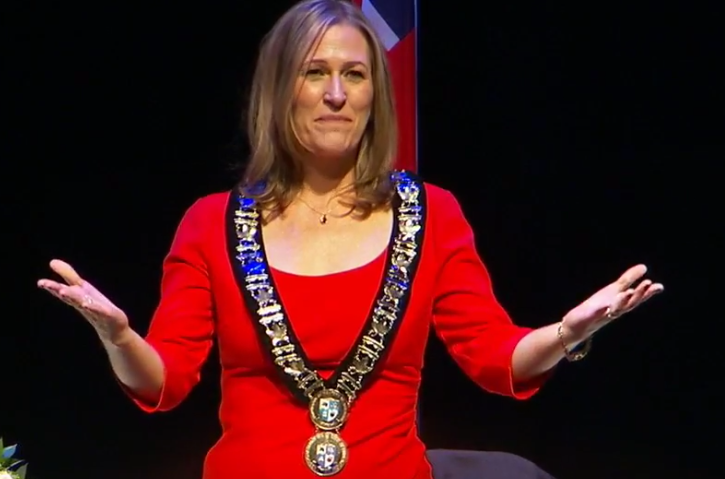 Mayor Marianne Meed Ward moments after being sworn in. “Burlington residents have consistently raised concerns about over intensification and development in our City. During the 2018 election, they made their voices heard and clearly indicated the need to review the scale and intensity of planned development, especially in the new Official Plan.
“As a result, I am bringing forward a motion to re-examine the policies of the Official Plan that was adopted, though not officially approved, in April of 2018, and review matters of height and density.
“Halton Region has also recently identified areas of non-conformity, so this motion seeks to gain the time to address those issues.
“Once the Region identified areas of non-conformity, that stopped the clock on approving the new Official Plan and opened the plan up for any other matters of discussion. This allows our new city council the time to define what areas we want to study, undertake that work, consult with the community, and send back a comprehensive plan. We expect that plan to truly reflect the needs, best interests and vision of the community and its elected council.
“The motion will also provide absolute clarity to staff and to the community that the City of Burlington staff are not to use the adopted 2018 plan in evaluating current/new development applications and that the existing Official Plan is still in full legal force and effect. Multiple analyses by staff in assessing development applications, downtown in particular, have made it clear we do not need to overintensify in order to meet our obligations under the Places To Grow legislation.
 “Further, we will immediately discontinue use of the “Grow Bold” term and related branding to ensure we “Further, we will immediately discontinue use of the “Grow Bold” term and related branding to ensure we
are absolutely clear on our direction.
“A timeline will be discussed at the next committee meeting.”
What we are seeing is a Mayor with her hands firmly hold the tiller on the ship of state.
The then Director of Planning for the city, Mary Lou Tanner, told city council that after polling people in the city they had decided to go with the tag line: Grow Bold, Grow Smart, Grow Beautiful. The words got placed on the door to the space on Locust Street that was rented for the Planning staff to work out of.
With the tag line gone – are the people that created it far behind?

|
|
 By Ray Rivers
By Ray Rivers


 Ray Rivers writes regularly on both federal and provincial politics, applying his more than 25 years as a federal bureaucrat to his thinking. Rivers was once a candidate for provincial office in Burlington. He was the founder of the Burlington citizen committee on sustainability at a time when climate warming was a hotly debated subject. Ray has a post graduate degree in economics that he earned at the University of Ottawa. Tweet @rayzrivers
Ray Rivers writes regularly on both federal and provincial politics, applying his more than 25 years as a federal bureaucrat to his thinking. Rivers was once a candidate for provincial office in Burlington. He was the founder of the Burlington citizen committee on sustainability at a time when climate warming was a hotly debated subject. Ray has a post graduate degree in economics that he earned at the University of Ottawa. Tweet @rayzrivers
















 1 to 5 storeys over the limit, XXX per floor
1 to 5 storeys over the limit, XXX per floor 1-19 km/h over the speed limit is a $2.50/km speeding fine.
1-19 km/h over the speed limit is a $2.50/km speeding fine. 30 to 50 cm, $1400 per tree removed
30 to 50 cm, $1400 per tree removed Jim Feilders is an engineer by training and an environmentalist by choice. He drives a hybrid car, heat and air conditions his house at a cost of of approximately $375 a year. The views expressed here are solely his own and not necessarily those of the various organizations with which he is associated.
Jim Feilders is an engineer by training and an environmentalist by choice. He drives a hybrid car, heat and air conditions his house at a cost of of approximately $375 a year. The views expressed here are solely his own and not necessarily those of the various organizations with which he is associated.





 This new proposal from Carriage Gate (the developer behind the 421 Brant St development which led to the creation of ECoB) suggests a level of massing, setbacks and overall height that massively exceeds both the in force Official Plan and the ‘Grow Bold’ Official Plan introduced by the last council. Regardless of one’s opinions at the 2018 municipal election, this development completely disregards all attempts by Council to moderate development downtown.
This new proposal from Carriage Gate (the developer behind the 421 Brant St development which led to the creation of ECoB) suggests a level of massing, setbacks and overall height that massively exceeds both the in force Official Plan and the ‘Grow Bold’ Official Plan introduced by the last council. Regardless of one’s opinions at the 2018 municipal election, this development completely disregards all attempts by Council to moderate development downtown.




 Alykhan Velshi, Brown’s chief of staff is a brilliant 30-something lawyer and policy analyst with credentials from the London School of Economics. He spent his formative years developing his skills as a neoconservative, first at the American Enterprise Institute and the Foundation for the Defence of Democracies, then as a political operative in the government of former PM Stephen Harper.
Alykhan Velshi, Brown’s chief of staff is a brilliant 30-something lawyer and policy analyst with credentials from the London School of Economics. He spent his formative years developing his skills as a neoconservative, first at the American Enterprise Institute and the Foundation for the Defence of Democracies, then as a political operative in the government of former PM Stephen Harper. In fact almost all of caucus officially supported Brown’s ‘People’s Guarantee” which was endorsed at the party’s November 2017 policy conference. Though Velshi’s previous mentor, Albertan Jason Kenny, stormed out of the conference once he realized that a carbon tax was one of those policies.
In fact almost all of caucus officially supported Brown’s ‘People’s Guarantee” which was endorsed at the party’s November 2017 policy conference. Though Velshi’s previous mentor, Albertan Jason Kenny, stormed out of the conference once he realized that a carbon tax was one of those policies.























 The Shape Burlington report set out what was wrong with city hall and what was needed in the way of change. Written by John Boich and former Mayor Walter Mulkewich who were served by a board of advisors, Senior city hall staff at the time didn’t want the report published – that wish wasn’t granted – they then wanted some changes in the wording.
The Shape Burlington report set out what was wrong with city hall and what was needed in the way of change. Written by John Boich and former Mayor Walter Mulkewich who were served by a board of advisors, Senior city hall staff at the time didn’t want the report published – that wish wasn’t granted – they then wanted some changes in the wording.







 There has been a lot of confusion about just where Burlington is in terms of the provincial government Places to Grow policy. That is the program that sets out the longer term population growth plans.
There has been a lot of confusion about just where Burlington is in terms of the provincial government Places to Grow policy. That is the program that sets out the longer term population growth plans.


























 “Further, we will immediately discontinue use of the “Grow Bold” term and related branding to ensure we
“Further, we will immediately discontinue use of the “Grow Bold” term and related branding to ensure we




